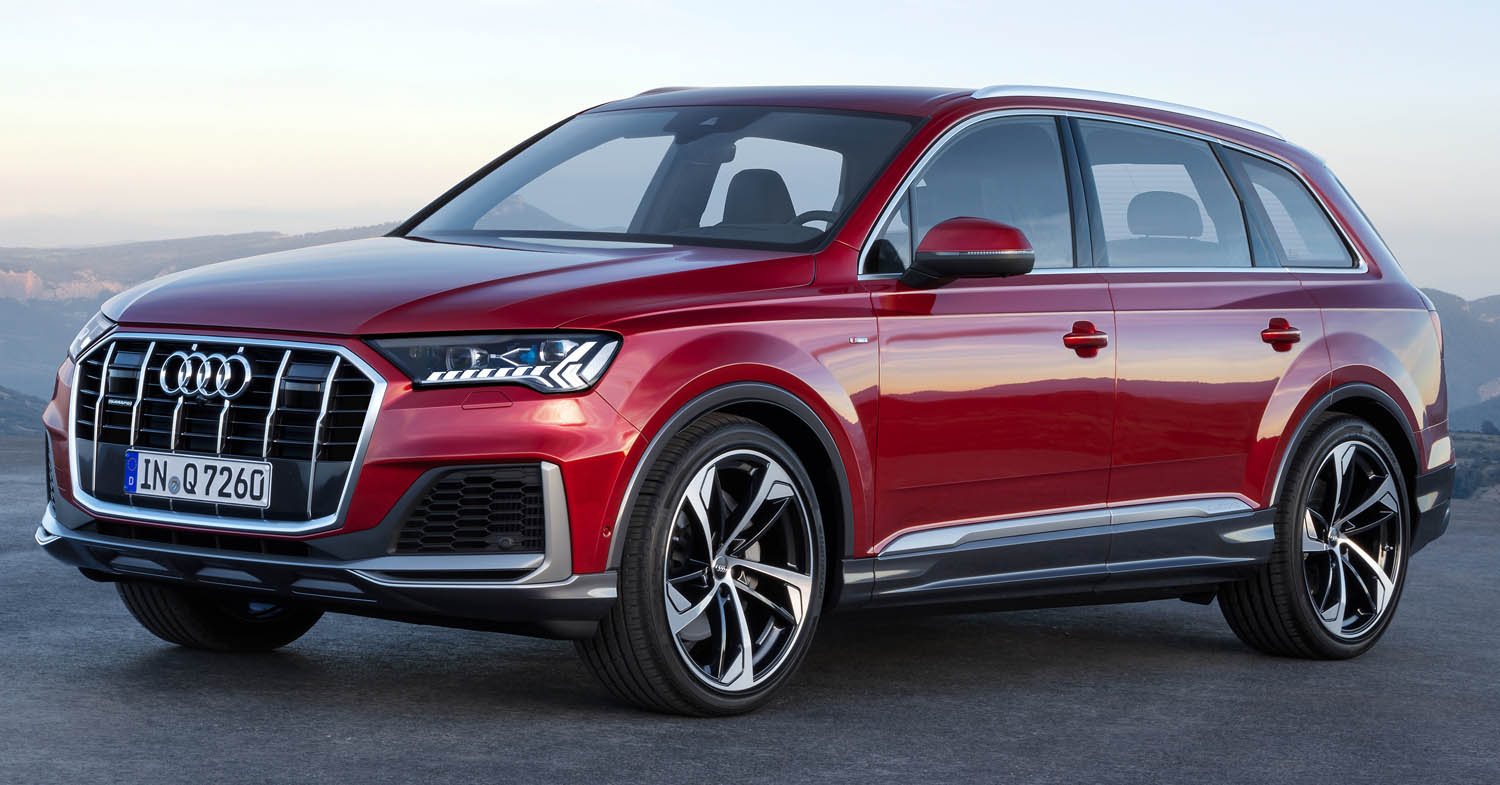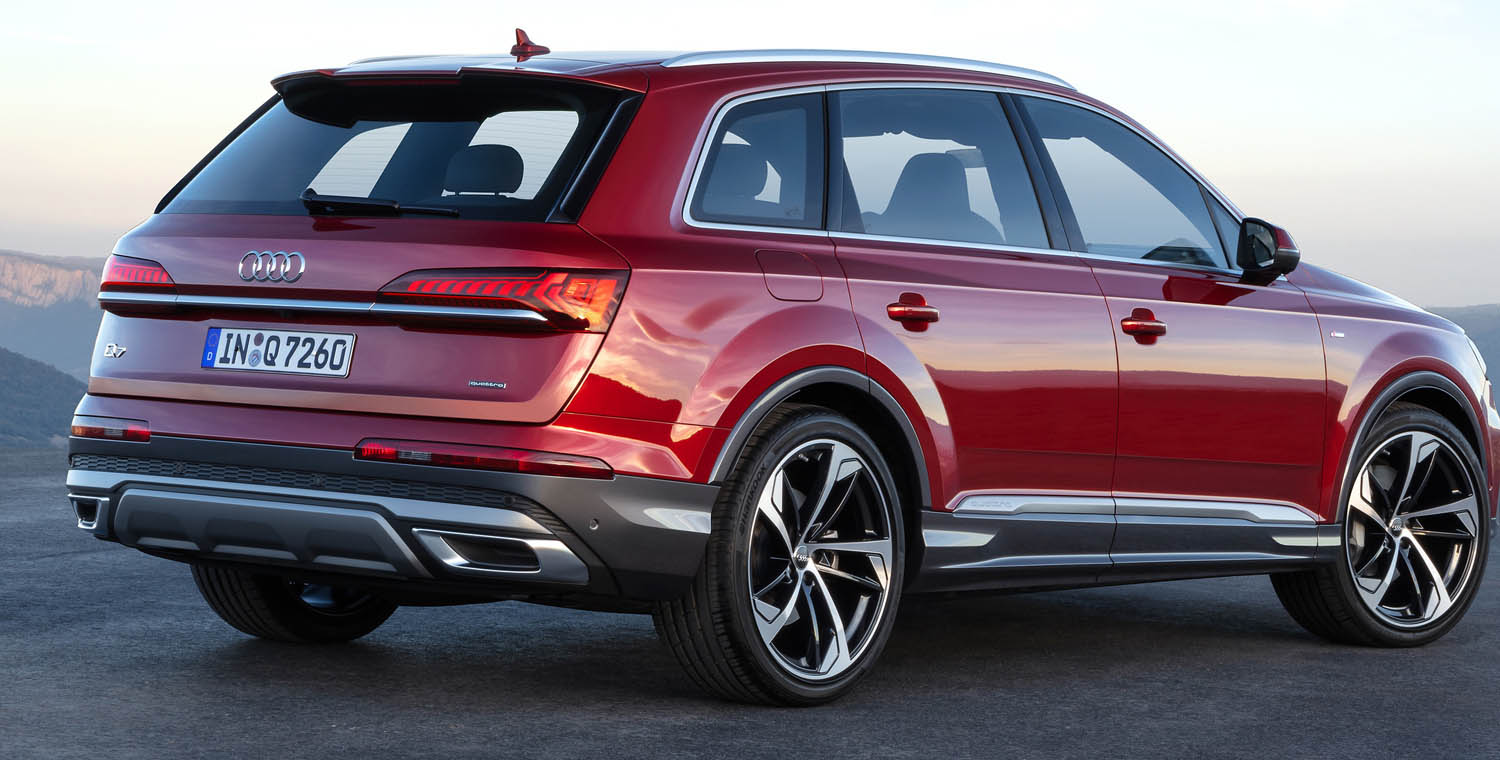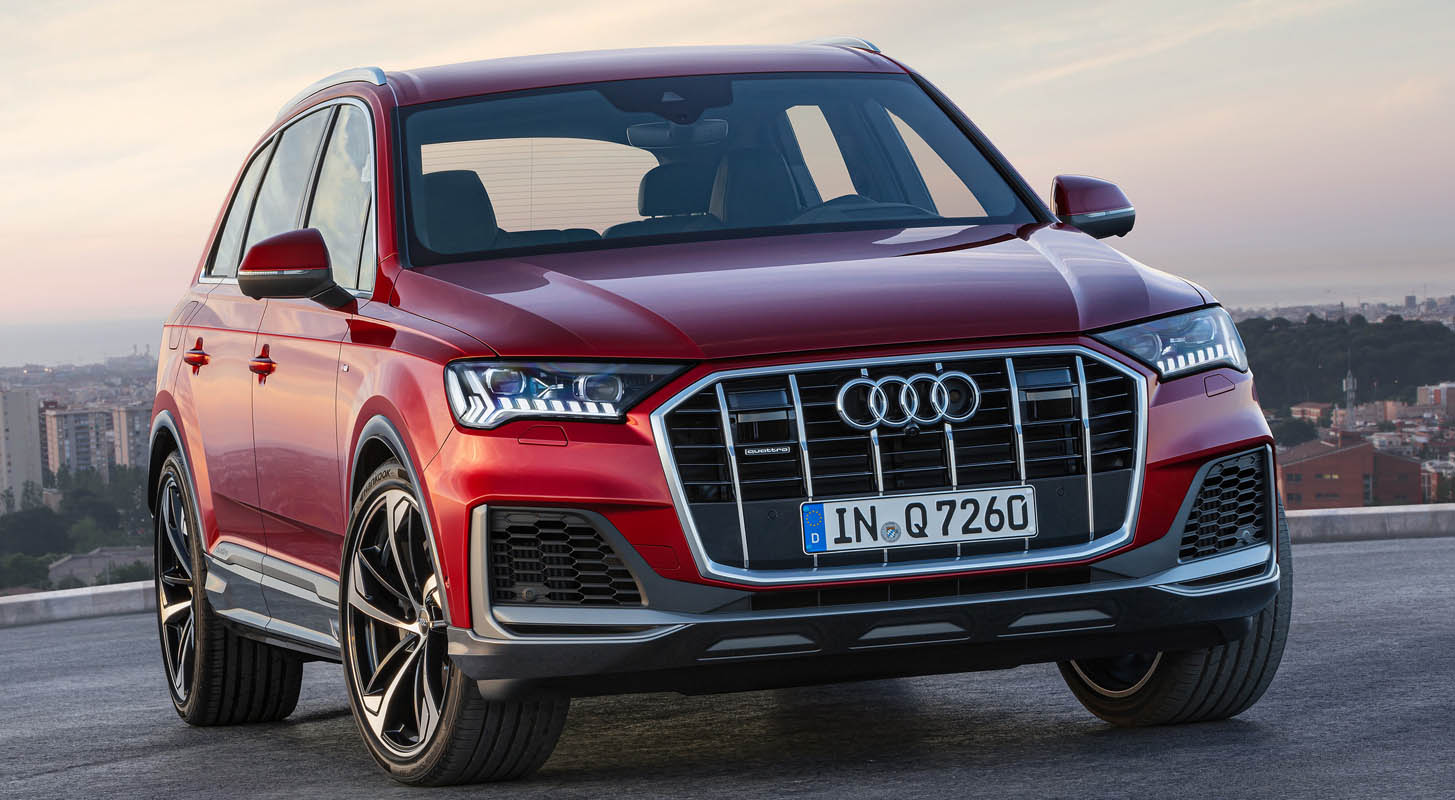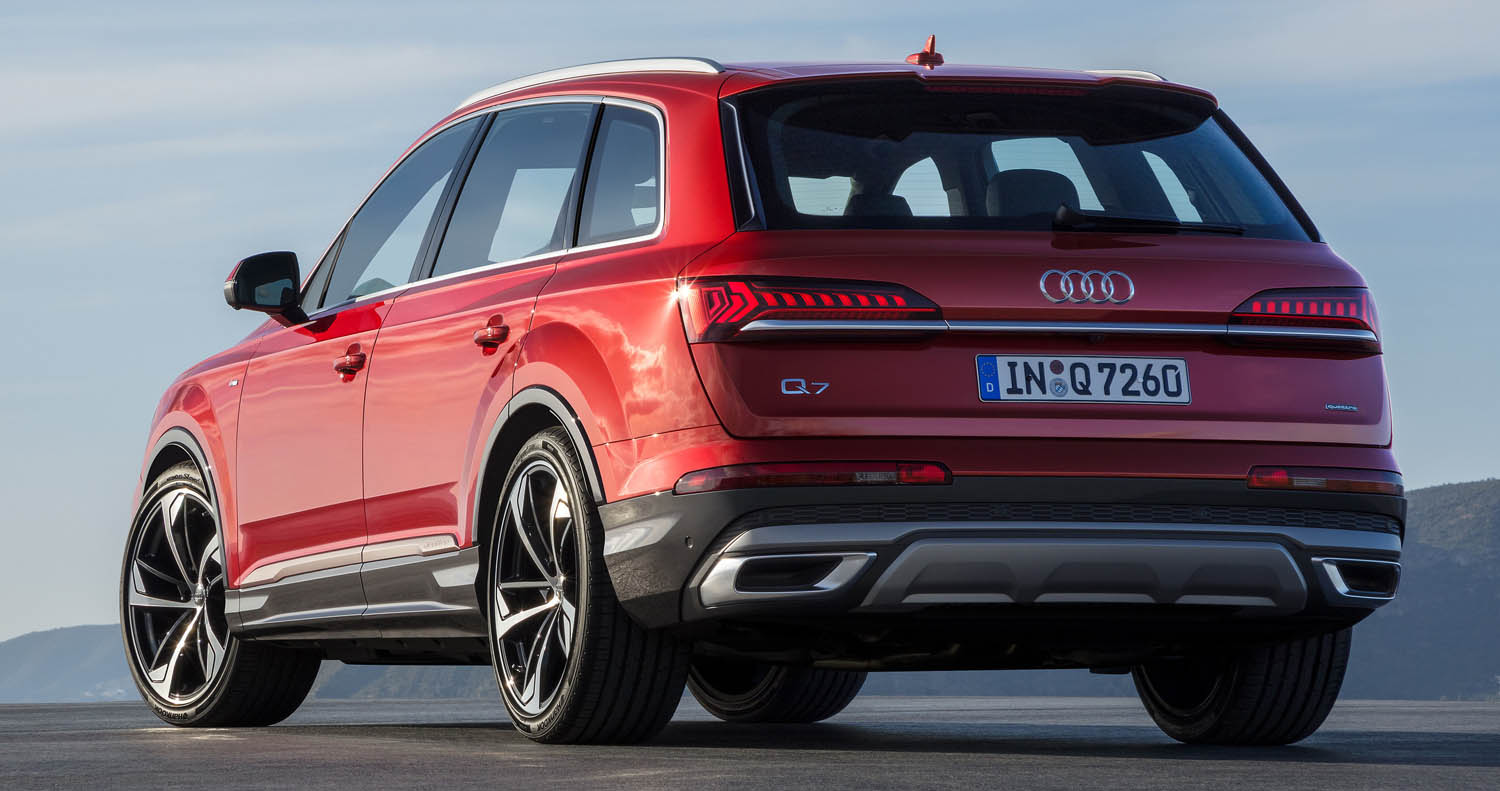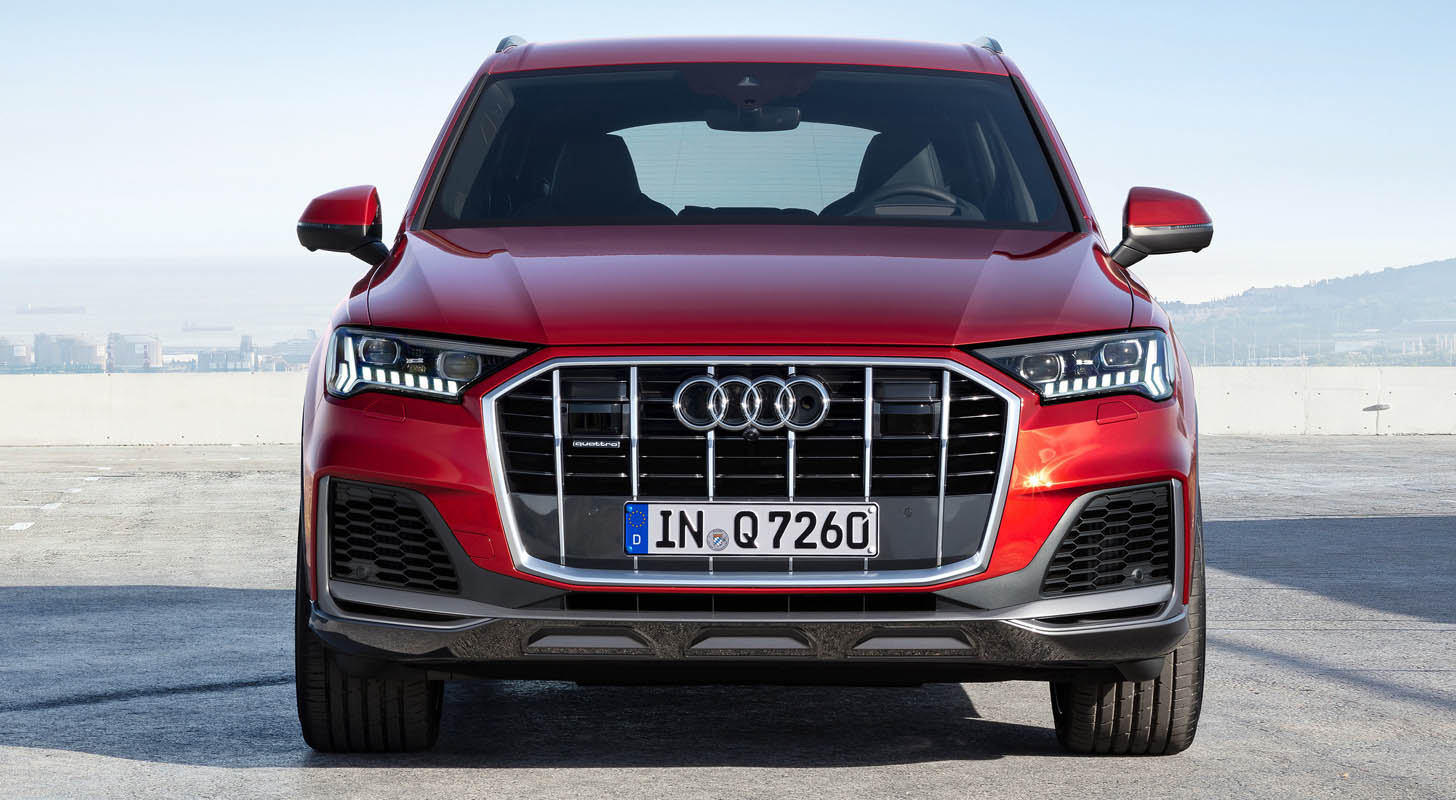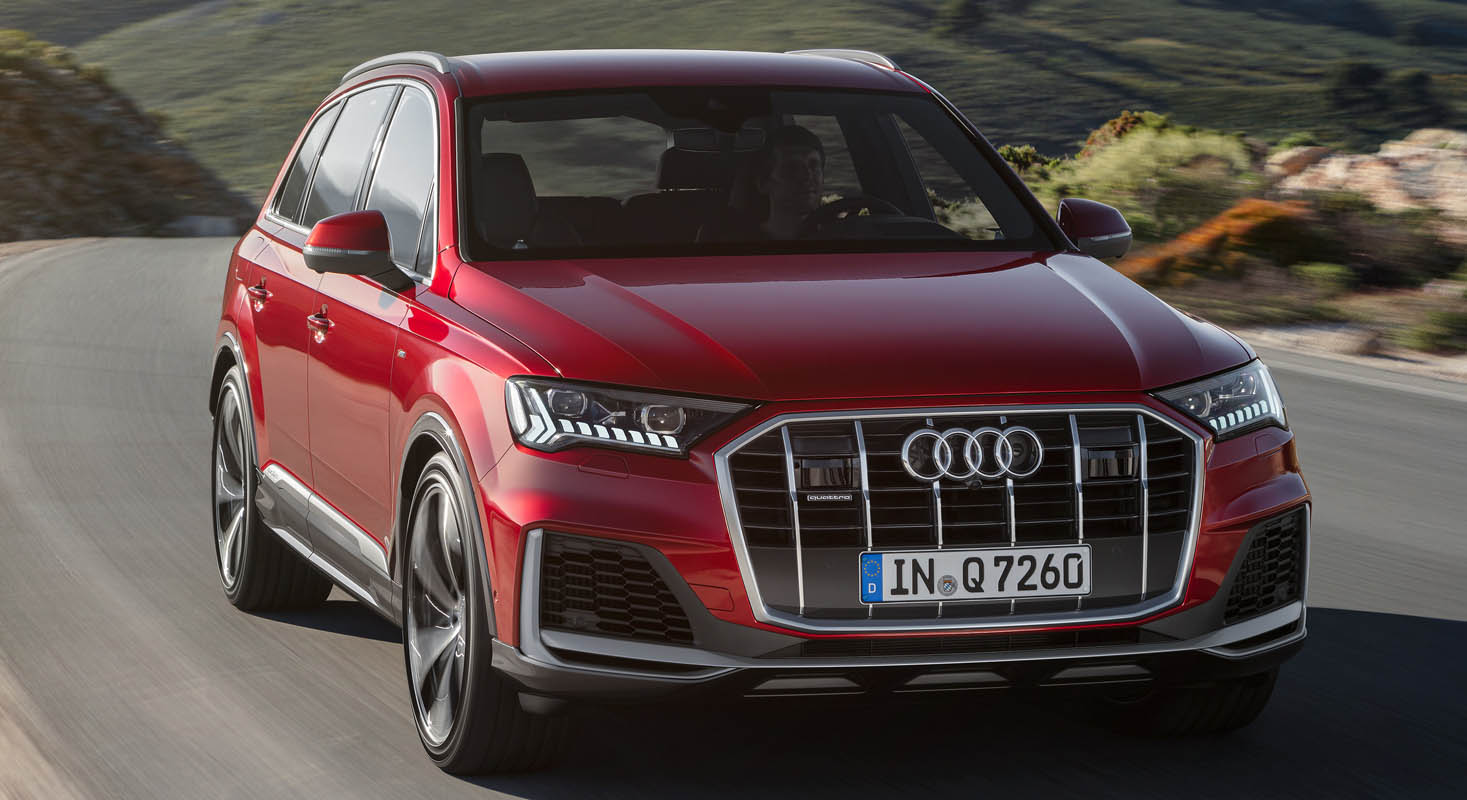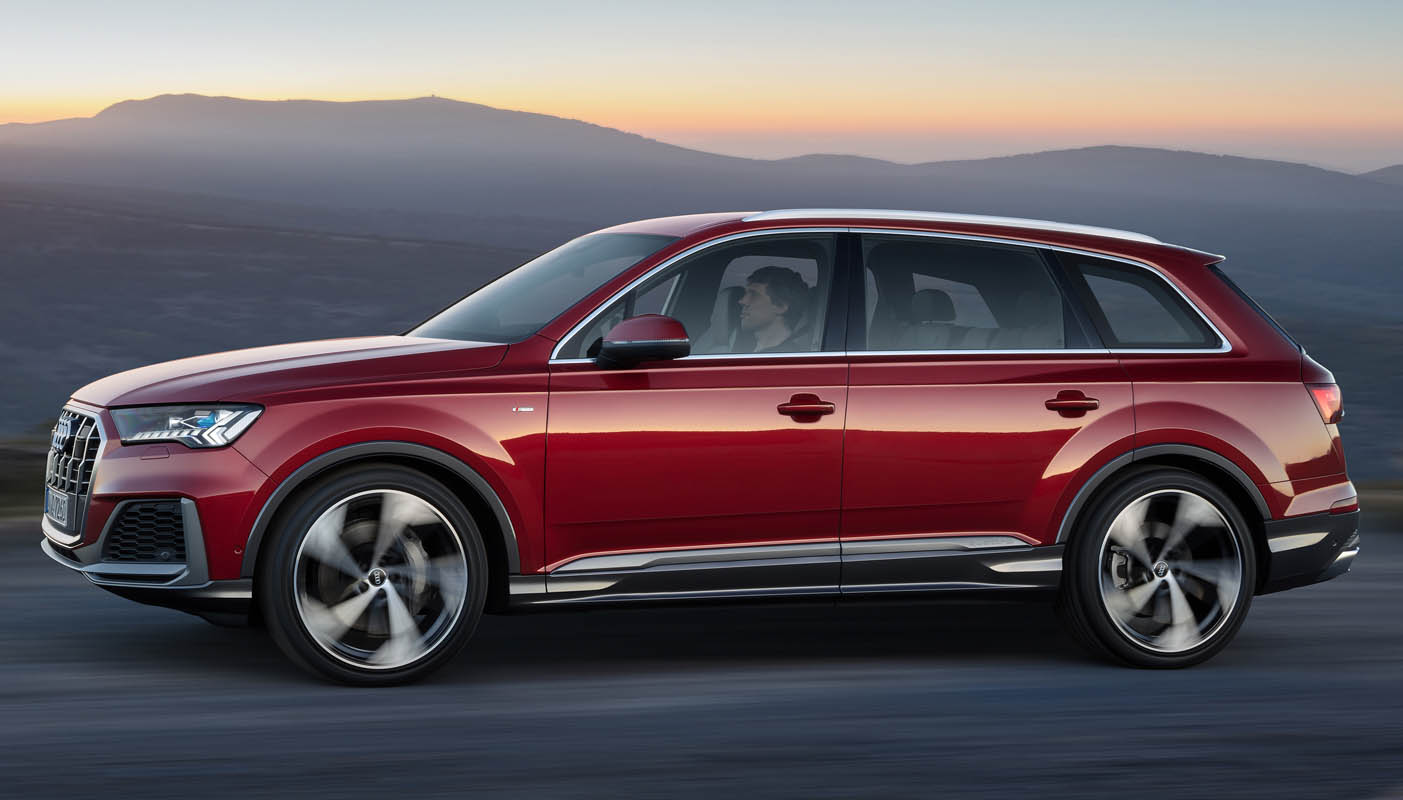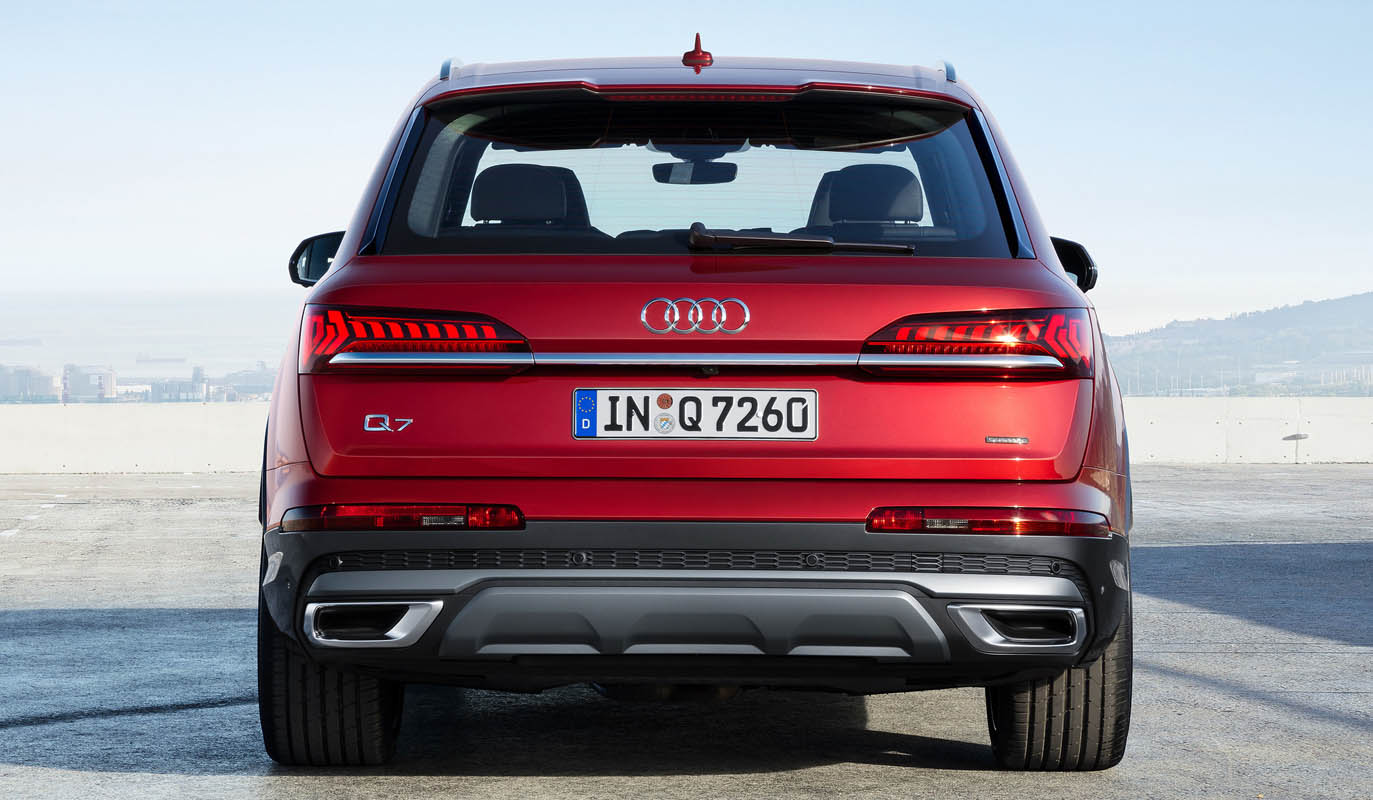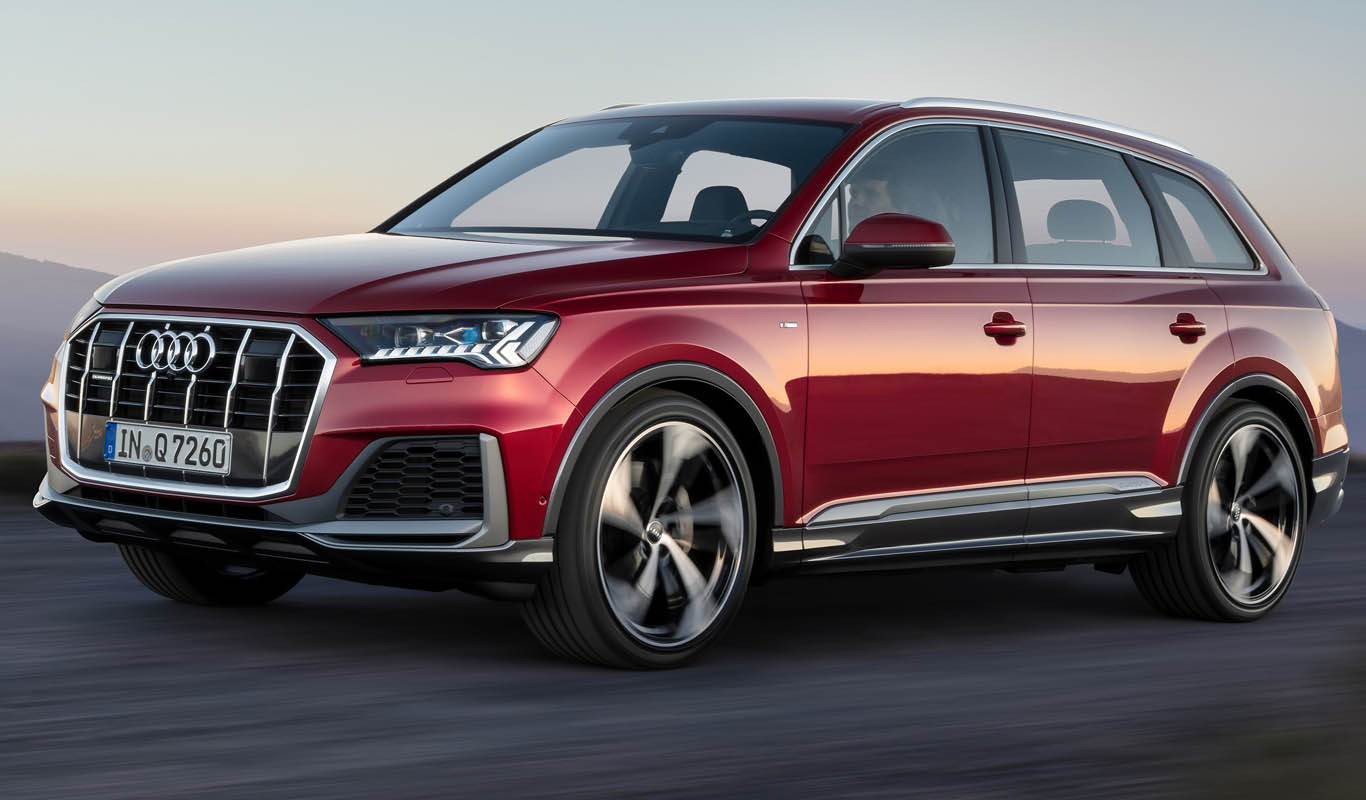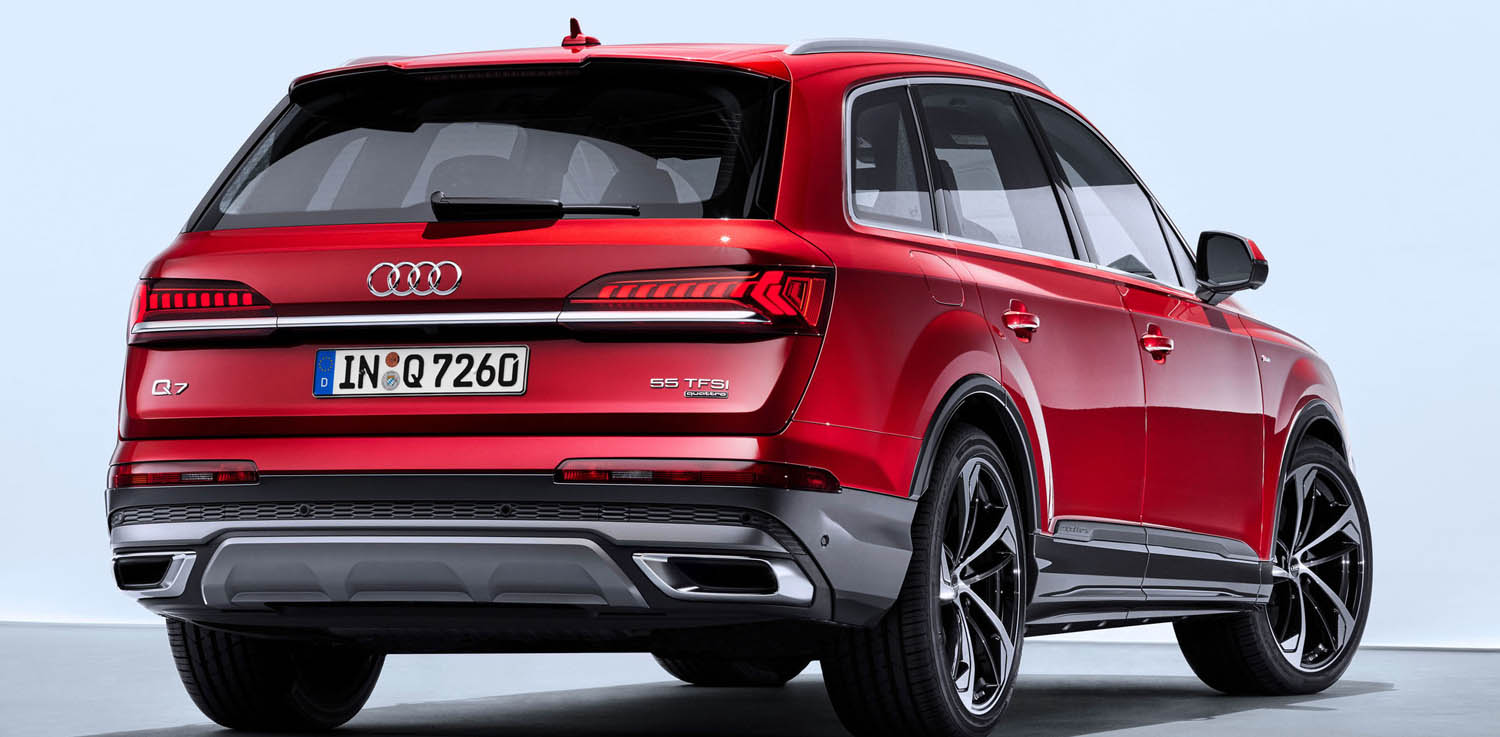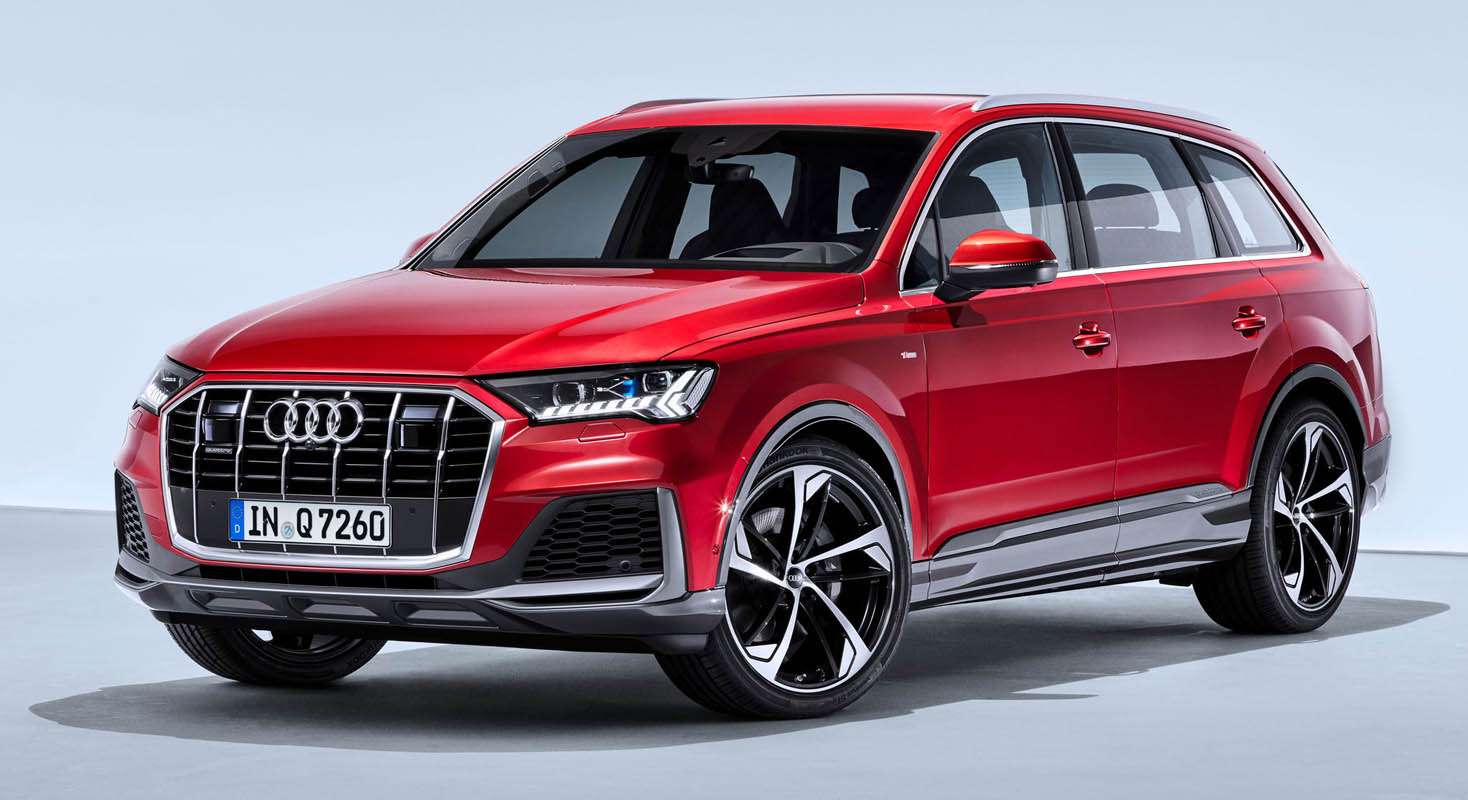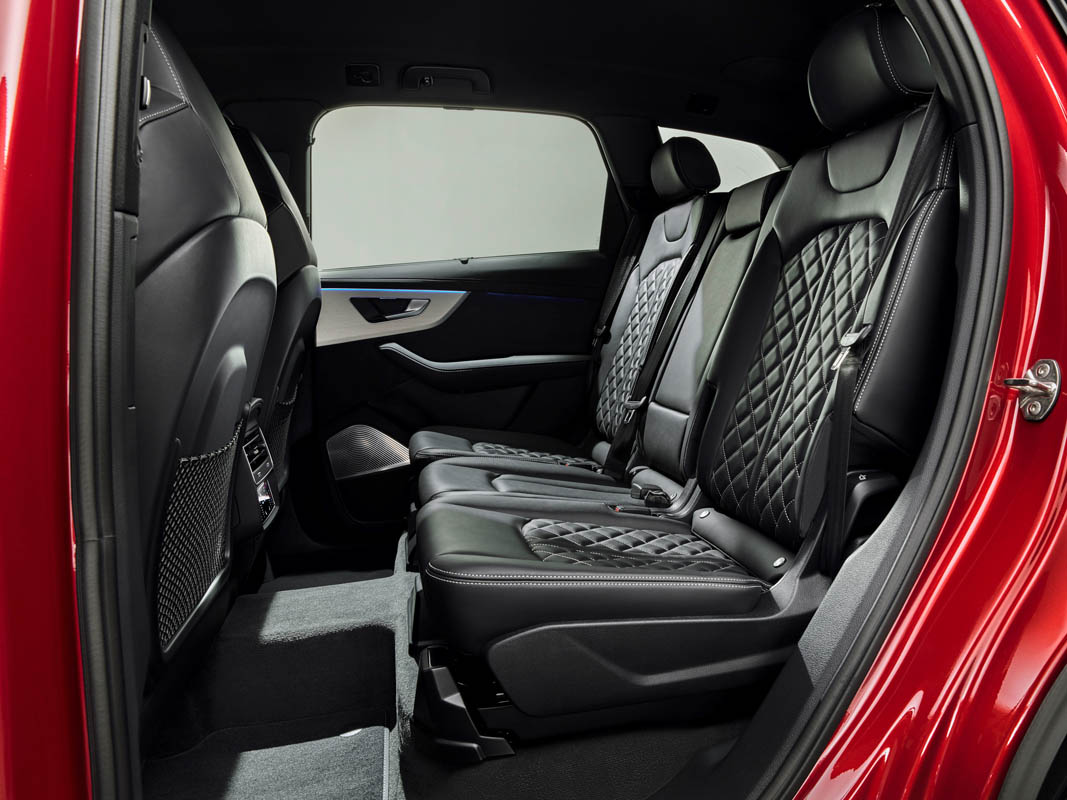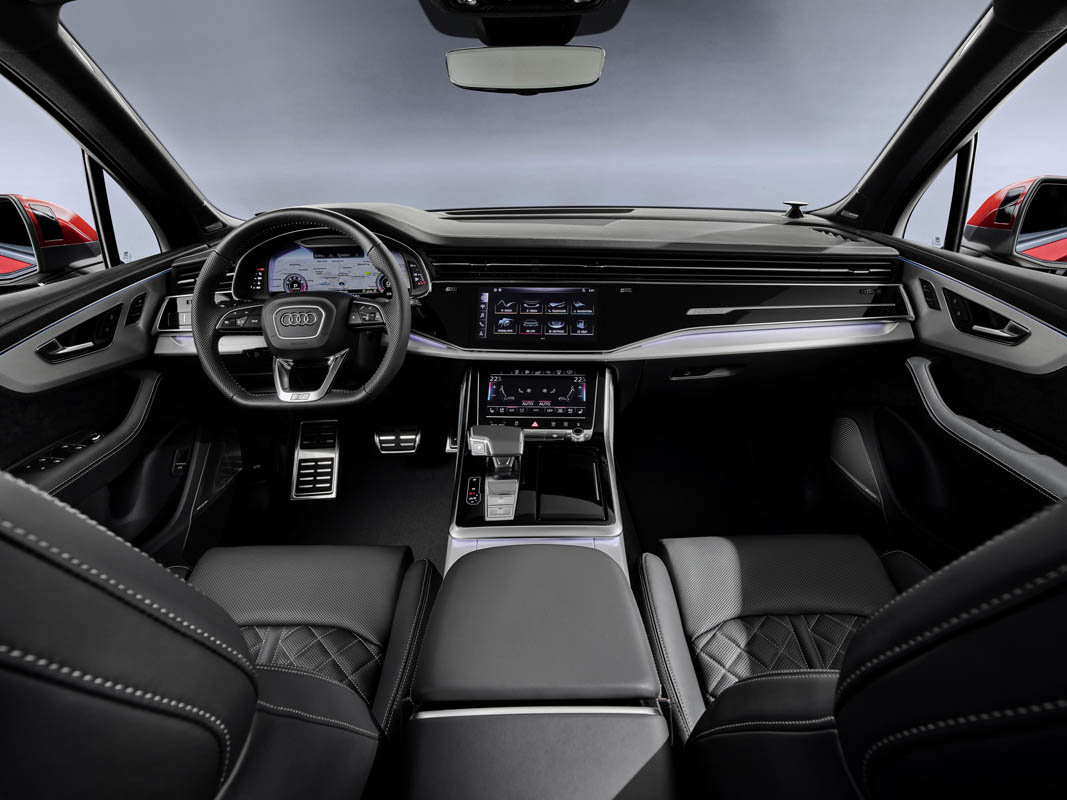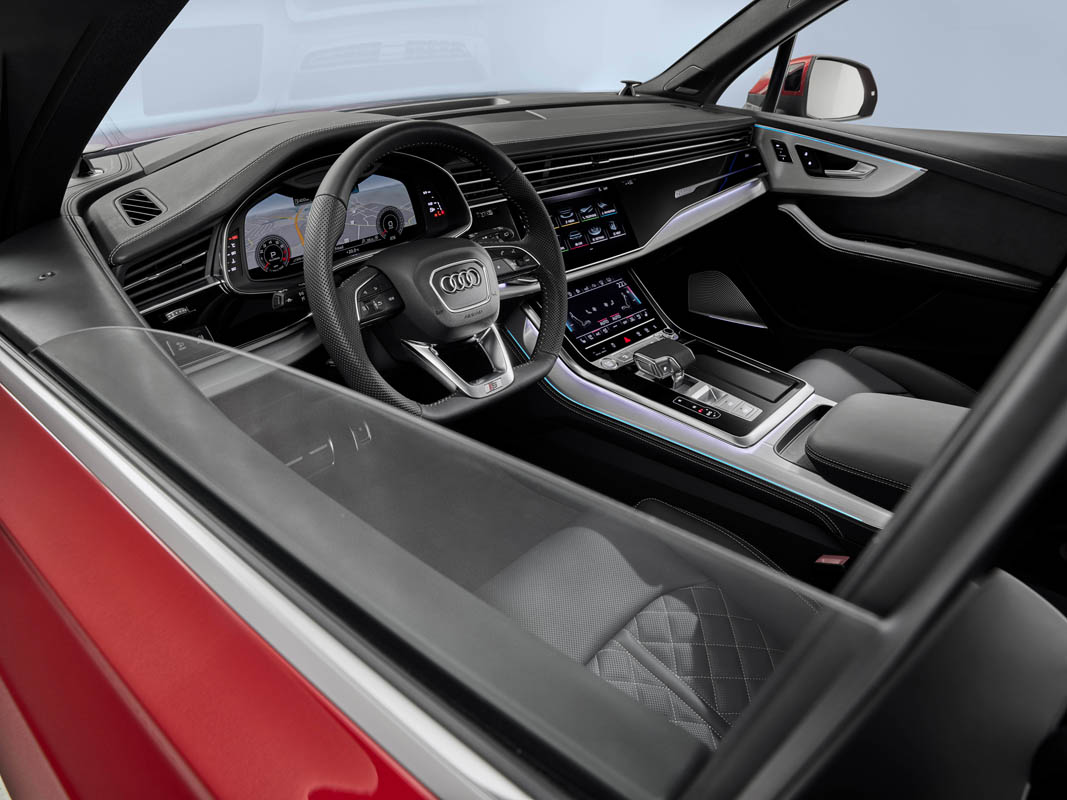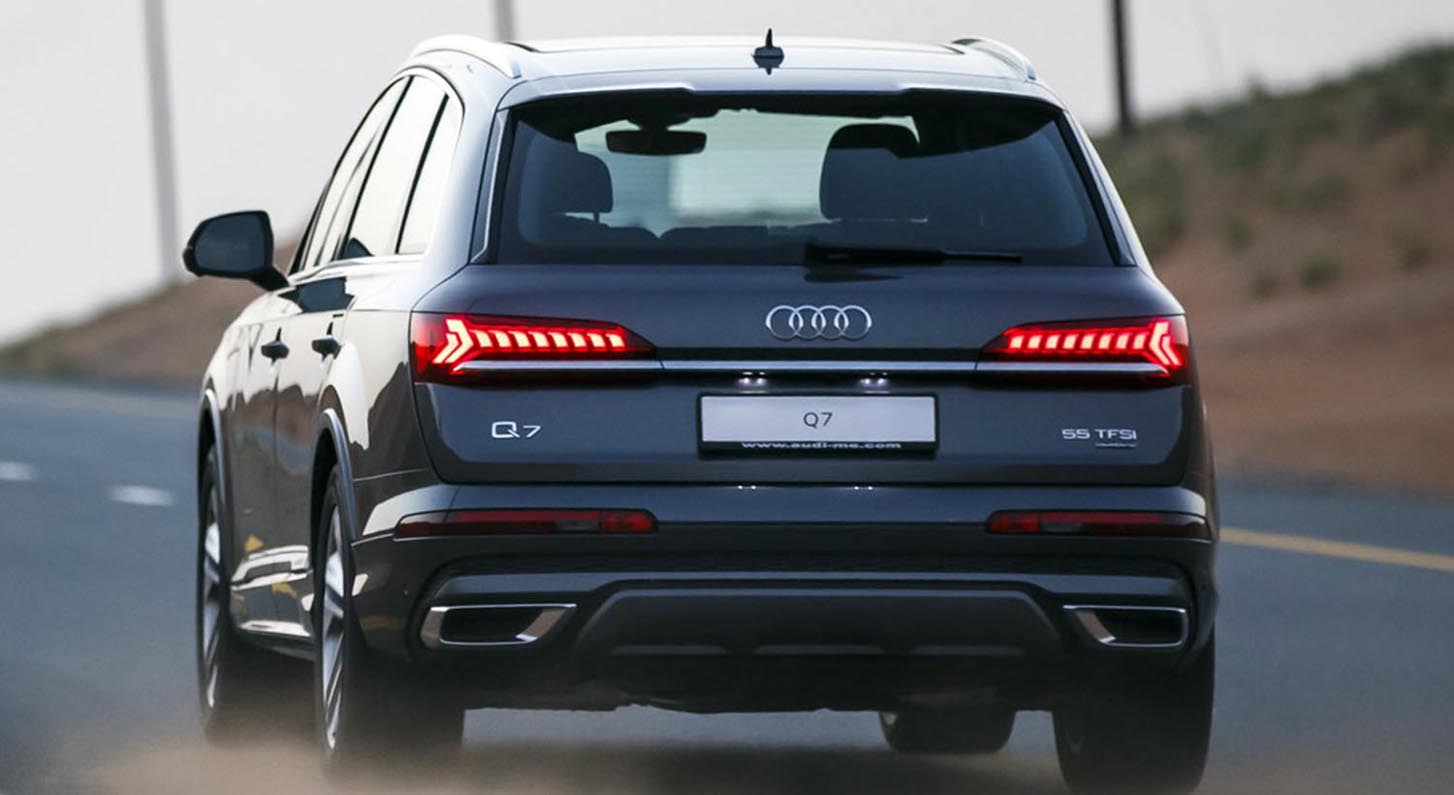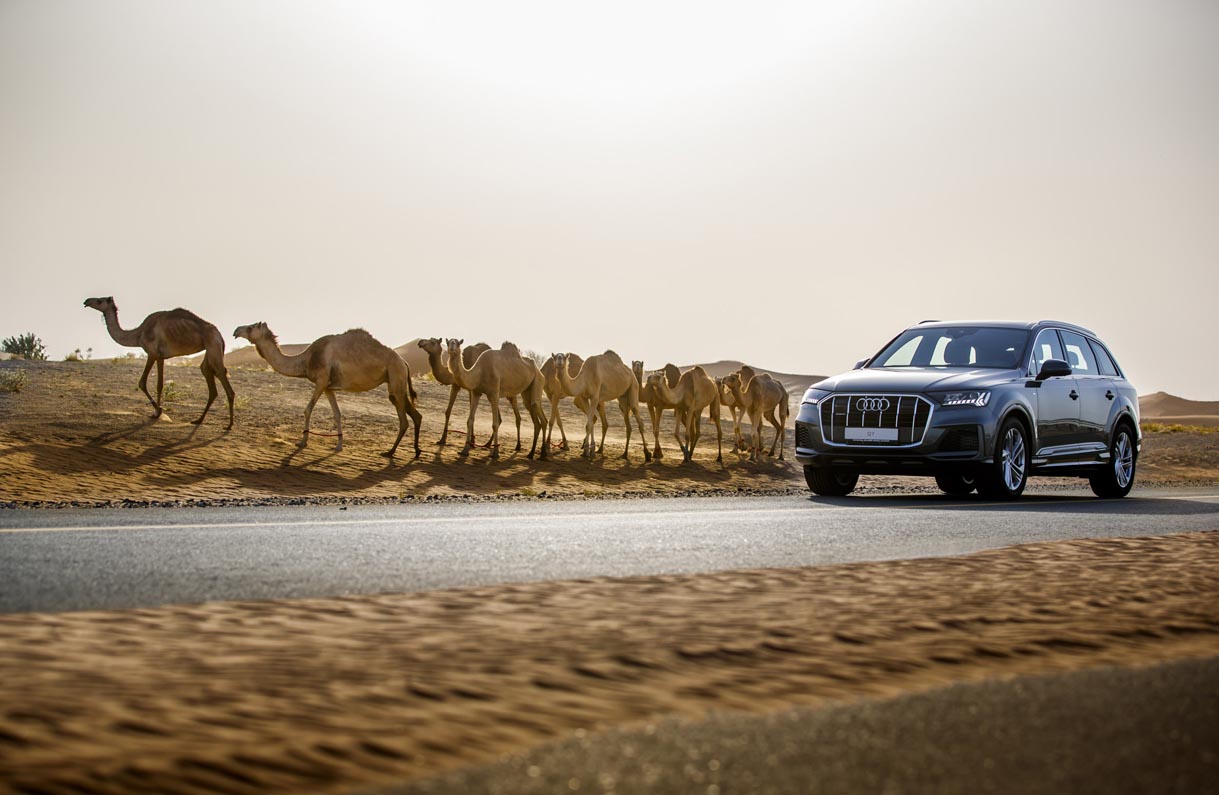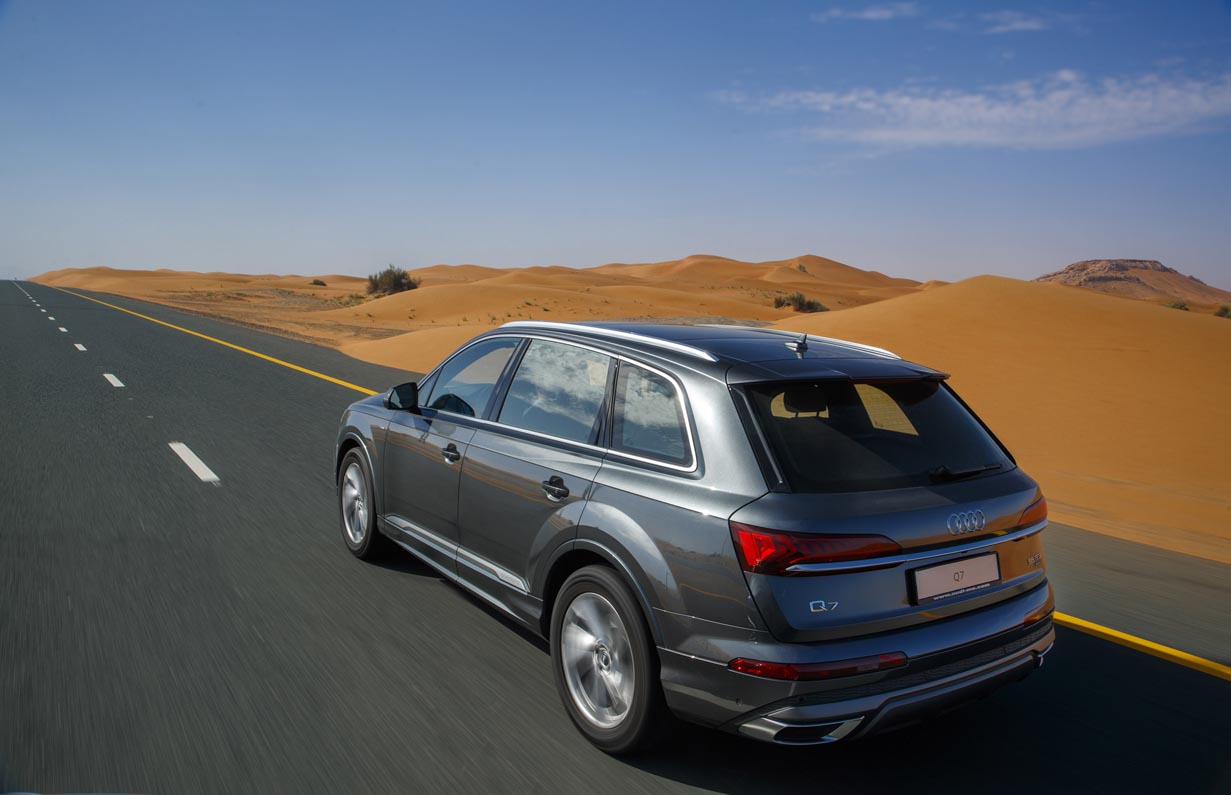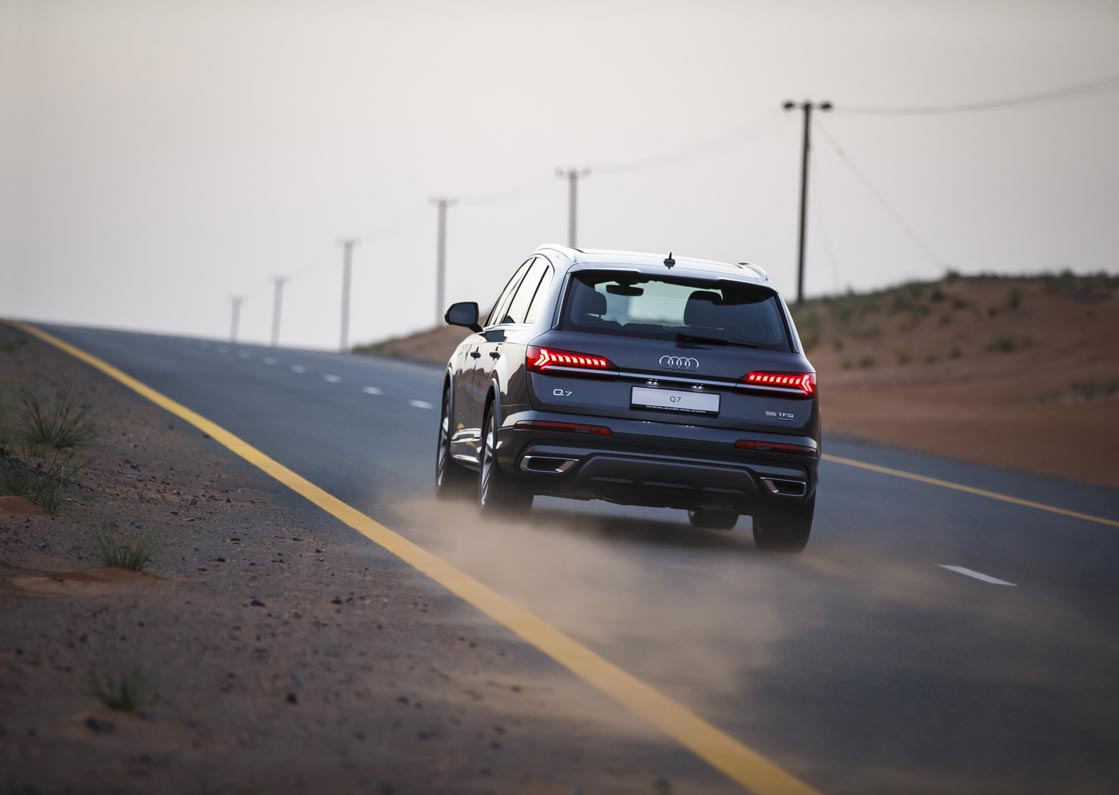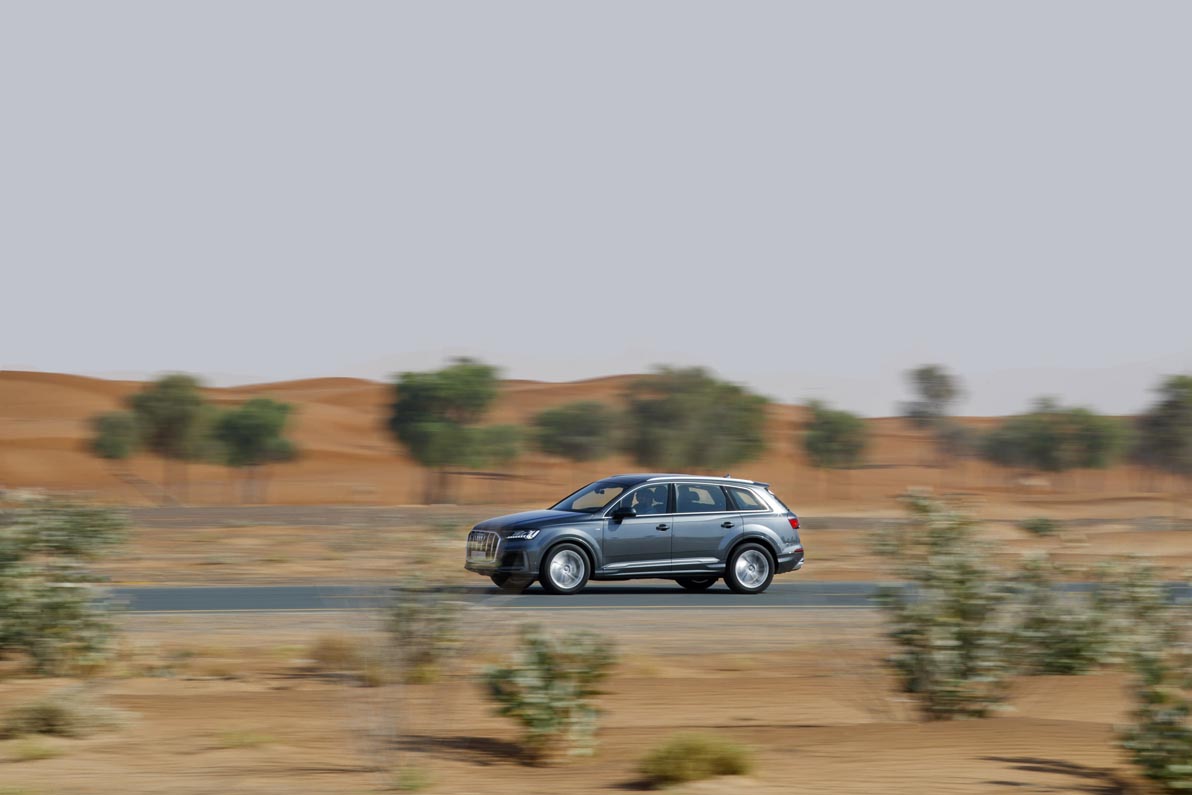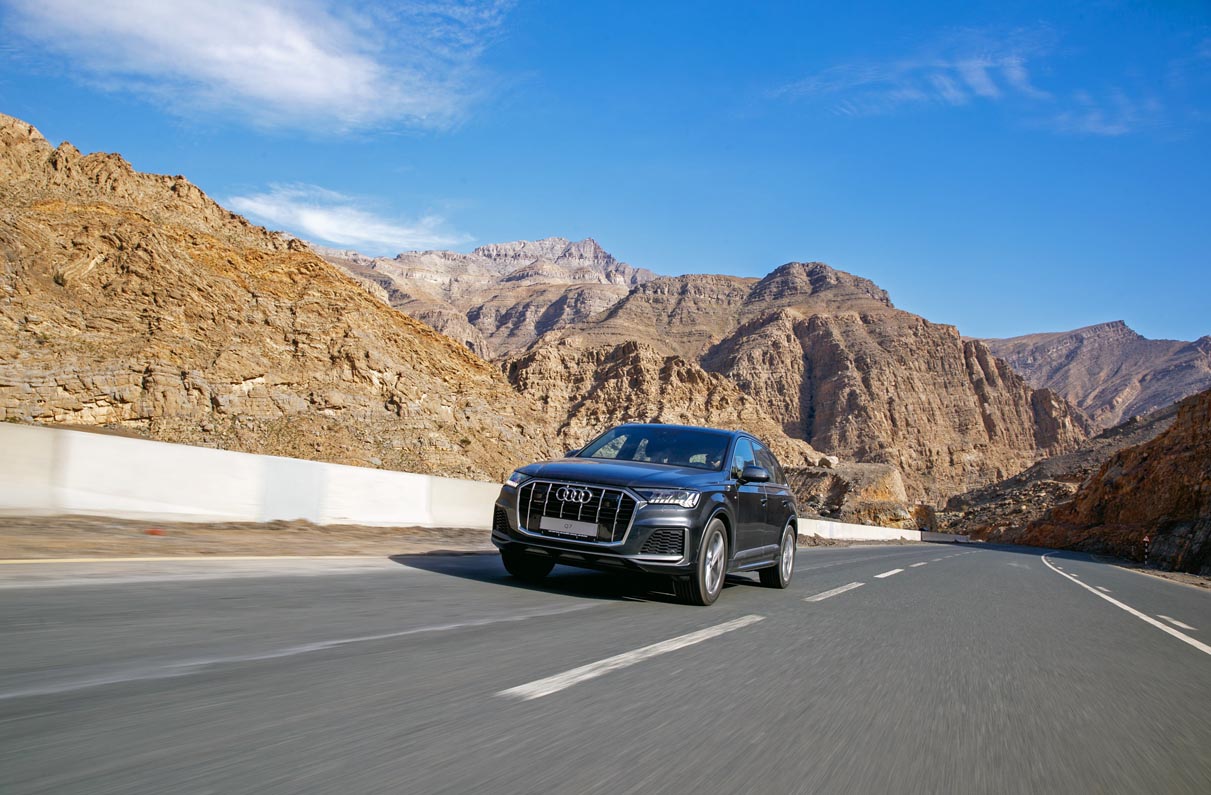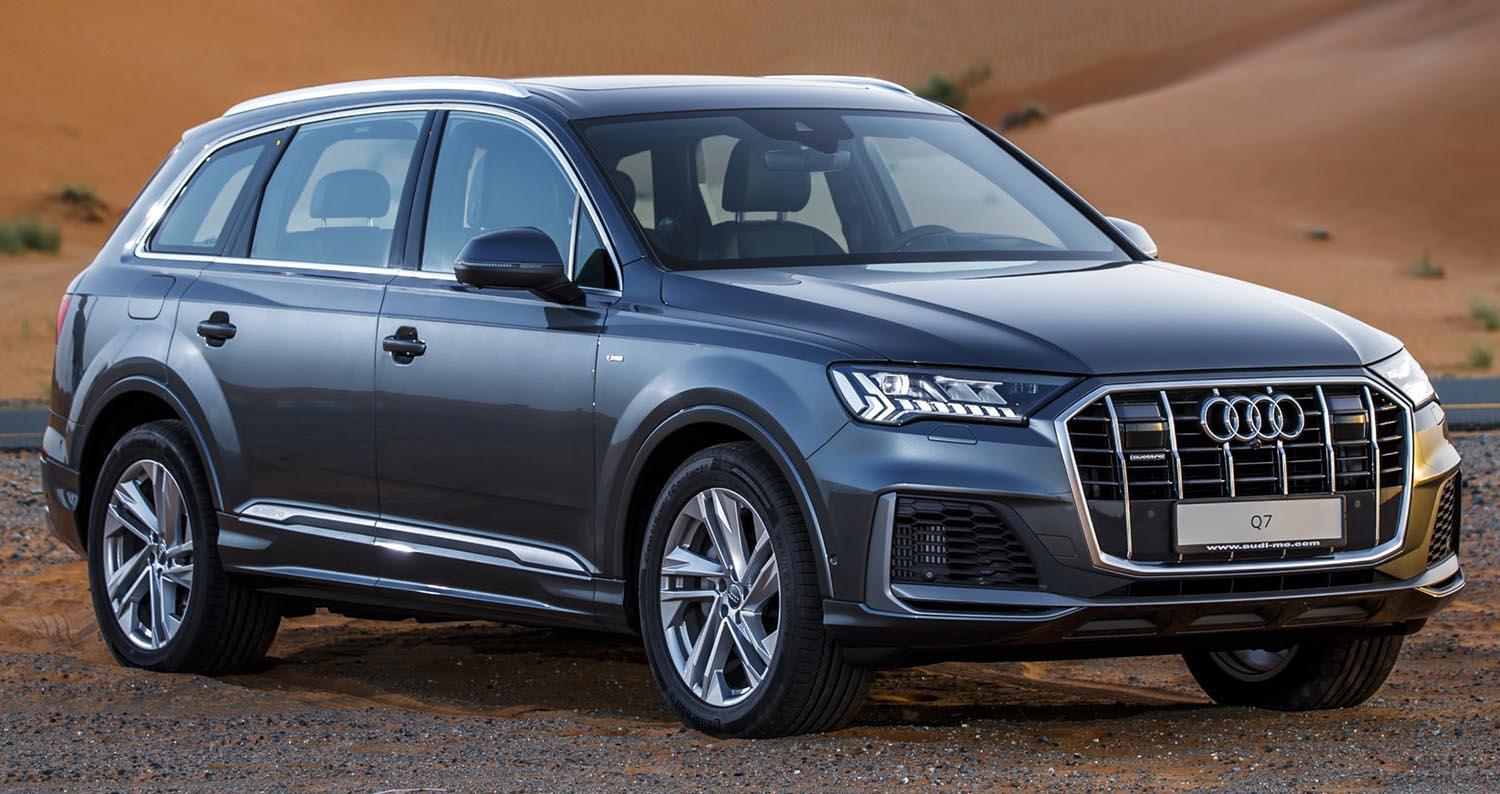
The Audi Q7 is getting an all-round update – both visually and technically. The large SUV features the new design of the Q family and offers superb dynamics and excellent comfort, in addition to its superior spaciousness. Mild hybrid technology, the digital operating concept, and the optional HD matrix LED headlights including laser light are just some of its highlights. The new Audi Q7 and the SQ7 are equipped with a powerful V8 diesel engine and will be introduced to the European market in mid-September. The base price for the Audi Q7 in Germany will be EUR 66,900.
Robust look: the exterior design
The Audi Q7 demonstrates the hallmark SUV elements in the current design language. It bears the large octagon-shaped Singleframe, with six upright slats providing the structure. As such, the SUV looks even more powerful. The two-part side air inlets have a much more expressive line, just like the sill area that underscores the large SUV’s ground clearance and, in turn, its offroad capabilities. The headlights, optionally in HD Matrix LED technology with Audi laser light, emphasize the width of the full-size model with their contour and light signature. On the restyled rear, a striking aluminum strip creates the visual connection between the flat rear lights with their technical-looking graphics and carries forward the horizontal body line. The designers achieved the clear view with taut, flat surfaces, which span the entire width particularly in the license plate region. The Audi Q7 is particularly striking with the optional S line exterior: A blade in the front bumper, sportily accentuated underbody protection at the rear along with full paint finish and 19-inch wheels come standard.
Sporty onroad, powerful off: the suspension
Audi has substantially enhanced the dynamic attributes of the Q7. The electromechanical active roll stabilization is available as an option for the large SUV. Adjustable stabilizers reduce the body movements on uneven roads when driving in a straight line. With a sporty driving style, the focus is on optimum roll compensation – the tendency of the car to lean into the bend is reduced substantially. All-wheel steering is also optionally available: The rear wheels turn by up to 5 degrees in the opposite direction at low speed, which increases agility. On the highway these wheels steer slightly in the same direction to promote stability. Thanks to the combination of these high-tech systems, the Audi Q7 is extremely maneuverable, precise and agile in urban traffic and on hairpin bends. In contrast, the Q7 behaves as a highly comfortable, confident touring SUV with excellent ride comfort on freeways – particularly in conjunction with the adaptive air suspension.
It also provides variable ground clearance and prepares the Audi Q7 with its standard quattro drive for terrain off the beaten track. The appropriate offroad mode can be selected via the Audi drive select dynamic handling system with its seven profiles. Air suspension comes standard on all seven-seater Q7 models. With the S line exterior, there is a slightly firmer adaptive air suspension sport. Because of this, the normal level of the body is 15 mm (0.6 in) lower than with an air spring suspension.
Mild hybrid technology standard: the drivetrain
All of the engines in the Audi Q7 are coupled to an eight-speed tiptronic and the quattro permanent all-wheel drive. A choice of two diesel engines and one gasoline engine will be available at first. A plug-in hybrid model combined with a V6 TFSI will follow later. In the Q7 45 TDI quattro tiptronic, the diesel unit produces 170 kW (231 metric hp) of power and 500 Nm (368.8 lb-ft) of torque. It accelerates the large SUV from a standstill to 100 km/h (62.1 mph) in 7.1 seconds and on to a top speed of 229 km/h (142.3 mph). The more powerful version in the Q7 50 TDI quattro tiptronic delivers 210 kW (286 metric hp) and 600 Nm (442.5 lb-ft). It sprints from zero to 100 km/h (62.1 mph) in 6.3 seconds; top speed is 241 km/h (149.8 mph).The new three-liter gasoline engine in the Audi Q7 55 TFSI quattro tiptronic is the most powerful engine. Just like the two diesel engines, the V6 gasoline engine is charged by a monoturbo. The key data: 250 kW (340 metric hp), 500 Nm (368.8 lb-ft) of torque, from zero to 100 km/h (62.1 mph) in 5.9 seconds, 250 km/h (155.3 mph) top speed (regulated).
The standard mild hybrid technology plays a major part in the efficiency of the engines. In customer operation, this technology can reduce consumption by up to 0.7 liters per 100 kilometers. Its central component, the belt alternator starter (BAS), powers a 48-volt main electrical system in which a compact lithium-ion battery stores the energy. During braking, the BAS can recover up to 8 kW of power and feed it back into the battery. If the driver takes their foot off the accelerator at speeds between 55 and 160 km/h (34.2 and 99.4 mph), the Audi Q7 recuperates energy, rolls in idle or coasts for up to 40 seconds with the engine switched off. The BAS restarts the engine the next time the accelerator is depressed, and does so faster and more gently than a conventional starter. The start-stop range begins at 22 km/h (13.7 mph).
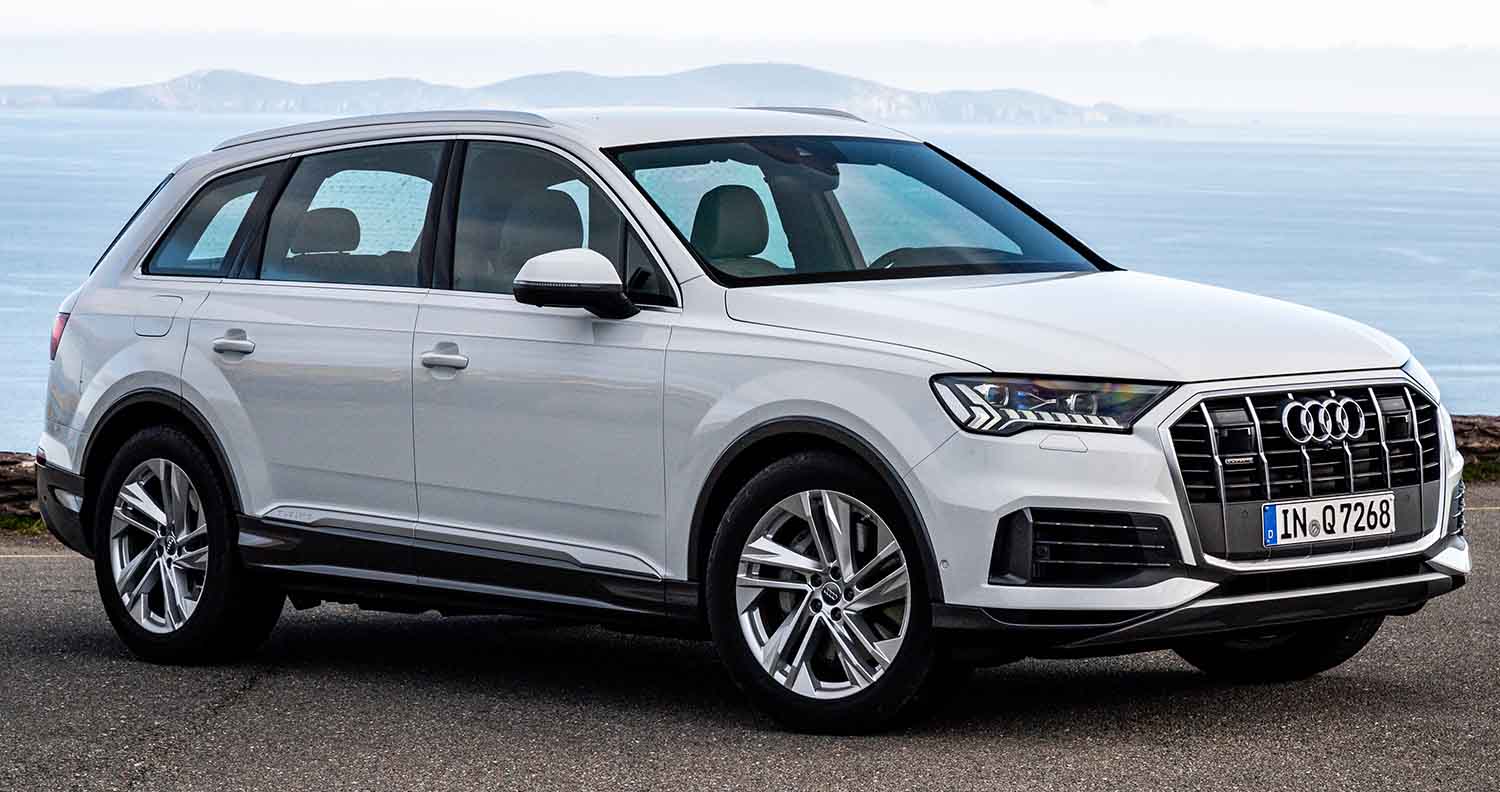
Luxury-class lounge: the interior
Whether with five or seven seats – the Audi Q7 combines immense prestige with practical everyday qualities. Through its new design, the large SUV has now grown eleven millimeters (0.4 in) to 5,063 millimeters (16.6 ft) long. It measures 1,970 millimeters (6.5 ft) wide and 1,741 millimeters (5.7 ft) (including roof antenna) high. The Audi Q7 outdoes its direct competitors with interior length as well as headroom and elbow room in the front and rear.
A host of storage compartments, a new compartment in the instrument panel as well as the generous load capacity provide highly functional utility value. Depending on the position of the rear seat backs the luggage compartment on the five-seater version offers between 865 and 2,050 liters (30.5-72.4 cu ft) of capacity – the latter with a flat load area. An electric tailgate is standard; foot-activated gesture control is available as an option. Audi optionally supplies the rear seat bench plus; all three seats can be moved individually fore/aft, the backrest angle can be adjusted, and there is a third seat row with two seats that can be lowered electrically.
The cockpit architecture harmonizes perfectly with the new, digital operating concept, which incorporates two large touchscreens. They provide haptic and acoustic feedback when clicking on the touch controls. When off, the top display slots almost invisibly into the large black decorative surface. All elements refer logically to one another, from the flat air vent strip to the wide console on the center tunnel. The optional contour ambient lighting package illuminates the interior in the dark. Convenient equipment options include four-zone automatic air conditioning, a power-assist function to close the doors quietly, the Bang & Olufsen 3D Advanced Sound System, and the air quality package with fragrancing and ionizer. Highlights in the seat lineup include the customized contour seats with their numerous adjustment functions and the S sport seats plus, both available with climate control and massage function.
High-end connectivity: Audi connect and assist systems
The MMI navigation plus delivers top-of-the-line connectivity. It features LTE Advanced, a Wi-Fi hotspot, natural voice control and the extensive Audi connect portfolio. The latter ranges from traffic information online, navigation with Google Earth, to the hybrid radio. The cloud-based Amazon voice service Alexa, which is integrated into the MMI operating system, is also new. The same applies to the Car-to-X service traffic light information, which is being rolled out in stages in selected European cities. Interconnection with the city’s infrastructure allows the vehicle to receive information from the central traffic light computer via a server, enabling the driver to select a speed to match the next green-light phase. The all-digital Audi virtual cockpit – and the optional head-up display – provide an individual speed recommendation as well as the remaining time until the next green-light phase if the driver is already waiting at a red light. The system thus contributes to a predictive and efficient driving style and facilitates a steady flow of traffic.
The adaptive cruise assist, which combines the functions of adaptive speed assist, traffic jam assist and active lane assist, reduces the driver’s workload – particularly on long journeys. In combination with efficiency assist it brakes and accelerates the Audi Q7 in anticipation of the conditions ahead. The emergency assist is also new: If the driver is inactive, the system brings the car to a stop and initiates protective and rescue measures. This function is active in assisted and manual modes.
Pure diesel power: the Audi SQ7 TDI
The product line is topped by the Audi SQ7 TDI.Its 4.0 TDI delivers 320 kW (435 metric hp) and 900 Nm (663.8 lb-ft) of torque. The V8 is supercharged by two turbos and accelerates the top model from 0 to 100 km/h (62.1 mph) in 4.8 seconds, and its top speed is electronically limited to 250 km/h (155.3 mph). The turbochargers are assisted by an electric powered compressor when accelerating from low speeds and when starting off. In the exhaust system, two actuators modulate the powerful eight-cylinder sound. An eight-speed tiptronic and the quattro permanent all-wheel drive put the immense power of the 4.0 TDI onto the road. To cope with this immense power, large brake discs, optionally made of carbon fiber ceramic, are installed behind the 20-inch wheels. The standard sport air suspension and progressive steering, whose ratio becomes increasingly direct as the steering angle increases, create excellent driving dynamics. Optional features include the electromechanically controlled active roll stabilization, all-wheel steering, and the sport differential that actively distributes the power between the rear wheels in fast corners. S-specific design details on the exterior and in the interior, which is kept in dark colors, emphasize the sporty and elegant character of the most powerful Q7. The MMI navigation plus and the Audi virtual cockpit, which features its own “S Performance” display, are included as standard. In Germany, the price for the SQ7 TDI is EUR 94,900.
Exterior and body
Whether it is for business or vacation, everyday errands or leisure time, has five or seven seats: The Audi Q7 is an all-rounder that combines immense prestige with a wide range of applications. Through its new design, the large SUV has now grown eleven millimeters (0.4 in) to 5,063 millimeters (16.6 ft) long. It is 1,970 millimeters (6.5 ft) wide and 1,741 millimeters (5.7 ft) high, including the steel suspension and roof antenna. The wheelbase of 2,994 millimeters (9.8 ft) remains unchanged.
Expressive exterior: imposing Singleframe and Audi laser light
The new Q7 demonstrates the hallmark SUV elements in the current Audi design language. Sharp edges and athletically taut surfaces convey power, high quality, prestige, and the power emanating from the quattro permanent all-wheel drive. The front alone is expressive: The large SUV bears an imposing octagonal Singleframe with six chromed, upright slats providing the structure. The side air inlets also have a much more expressive line. The headlights with their new contour and light signature emphasize the width of the full-size model: Running from the radiator grille outward, they increase in volume and extend slightly down into the wing.
The Audi Q7 is equipped with LED headlights as standard. While matrix LED headlights constitute the first basic option; HD matrix LED headlights with Audi laser light, each of which feature 64 LEDs and a high-performance laser diode, are also available The laser module can be identified by its X-shaped contour with a blue LED. It is activated beginning at a speed of about 70 km/h (43.5 mph) and increases the range of the high beam significantly. Arranged in two rows one above the other, the high beam of the HD Matrix technology illuminates the road extremely precisely and dynamically. Individual light segments are switched on or off so as to prevent other road users from being blinded. The light cone omits only the corresponding area.
The LEDs also act as cornering lights, created through a displacement of the light concentration following the contour of the bend. This occurs already shortly before the wheel is turned, based on the predictive route data from MMI navigation plus. The intersection light also goes on predictively just before an intersection is reached. Furthermore, the turning light extends the lateral illumination up to a maximum angle of 80 degrees. The daytime running lights, which are divided into small vertical segments, have a three-dimensional effect. Just like the rear lights, the headlights incorporate the dynamic turn signal and impressively showcase the Audi Q7 when locking and unlocking it.
Greater effect of width: Newly designed side and rear
Looking at the vehicle from the side, the trapezoidal sill trim area visually reduces the volume of the Audi Q7, thereby underlining its offroad capabilities. The horizontal body line continues along the newly designed rear in the form of an eye-catching aluminum strip. It connects the flat tail lamps that extend far into the sides and whose tail light takes up and interprets the motif of the daytime running light signature. The strip underlines the width of the vehicle, as does the surface in the area of the license plate, which is now flat. The horizontal bracket that extends around the diffusor and the underbody protection completes the prestigious appearance of the Audi Q7.
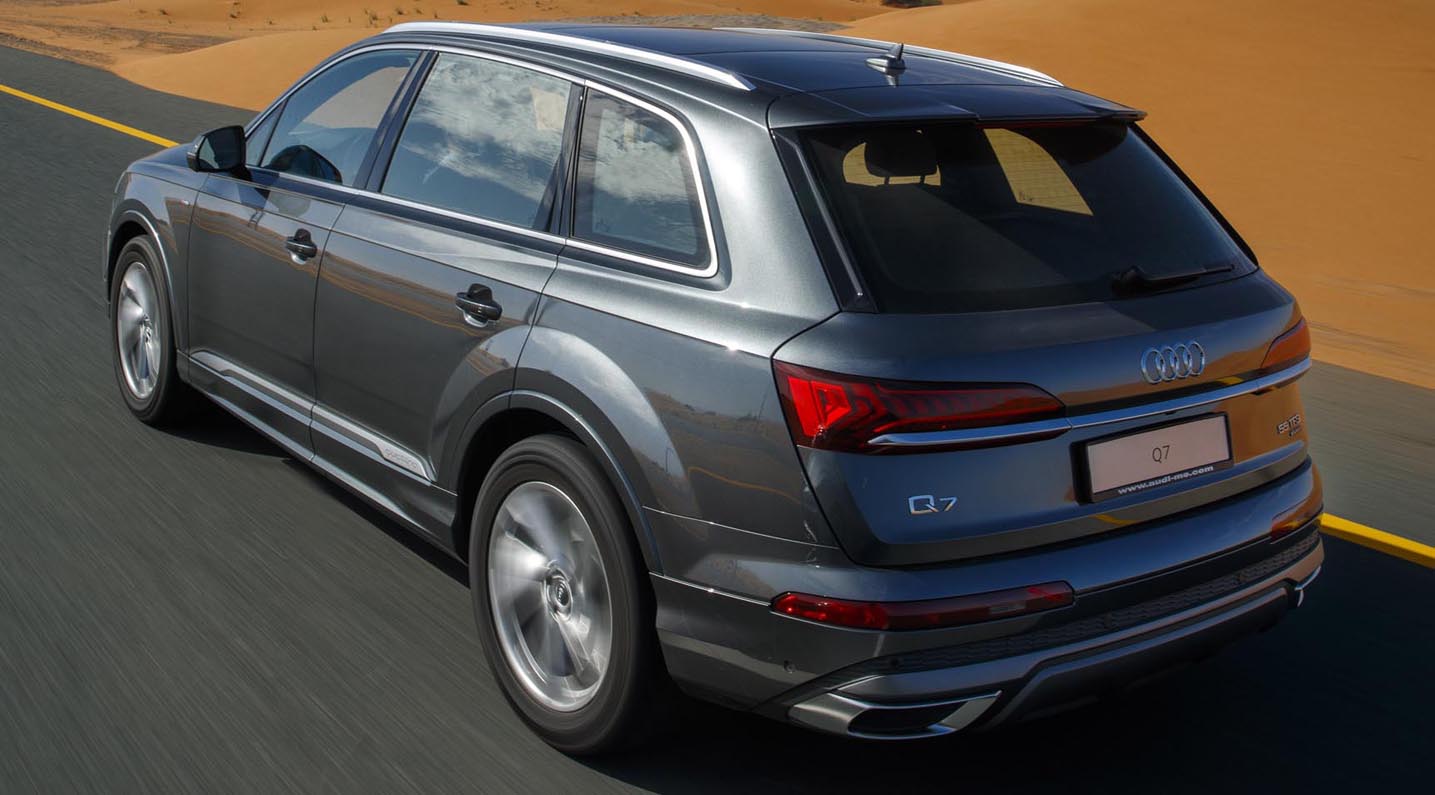
Offroad look: Equipment lines and colors
Anthracite textured paint, which is applied as standard to the front spoiler, wheel arch trims, diffusor, and sill trim area, underlines the SUV character and makes the body appear higher. In the case of the optional S line exterior, the Audi Q7 is painted entirely in body color and is even more striking – with a blade in the front bumper, a sporty roof edge spoiler, and an eye-catching underbody protection at the rear. 19-inch wheels are also included, with the option of exclusive 20-inch wheels. Contrasting paint finish in high-gloss scandium gray and the black styling package are available for the basic and S line exterior models. The black styling package adds highlights to the Singleframe, the bumper and the side door inlays. Carbon running boards and exterior mirrors can also be ordered; the latter are also available in glossy titanium black.
A total of twelve exterior colors are available for the Audi Q7, including the new metallic colors Vicuña beige, Barrique brown, and Matador red. The two plain colors are called Carrara white and Night black. The color Daytona gray, pearl effect is available exclusively for the S line exterior. Audi exclusive customized paint finishes complement the extensive offer.
Intelligent mix: the multi-material body
The body of the Audi Q7 is designed as a multi-material construction. The entire outer skin including the roof and the doors is made of aluminum. Even the front roof crossmember and the D- and C-pillars are made out of the lightweight metal. A compound of hot-formed steels forms the strong backbone of the passenger cell. The material combines extreme strength with low weight and is used in the A- and B-pillars. The lower area of the windshield is also made of steel.
With its high level of rigidity, the Audi Q7 lays the foundation for the uncompromising manufacturing quality, precise handling characteristics, and confident calmness on board, which is supported by the high aeroacoustic finishing. A double-layer windshield is standard. Audi also offers acoustic glazing for the side windows as an option.
Suspension
Audi has substantially enhanced the dynamic attributes of the Audi Q7. The confident ride comfort remains unchanged. In addition to the optimized all-wheel steering, the electromechanical active roll stabilization can be used as an option. Thanks to this combination, the large SUV is extremely maneuverable, precise, and agile on curvy country roads. Even when driving in urban traffic, the Audi Q7 makes full use of its maneuverability. In contrast, the Q7 behaves as a highly comfortable, poised touring SUV with excellent ride comfort on freeways – particularly in conjunction with the adaptive air suspension. It also provides variable ground clearance and prepares the Audi Q7 with its standard quattro drive for terrain off the beaten track.
Even greater agility: All-wheel steering and active roll stabilization
The Audi Q7 features electromechanical, speed-sensitive power steering as standard. It provides differentiated feedback from the road, and responds spontaneously and with great precision. It provides excellent assistance while maneuvering, which is reduced as the speed increases. The large SUV is even more maneuverable with the optional all-wheel steering, which is managed by the electronic chassis platform. It is available as part of the advanced suspension package or as an individual option. The front-axle steering ratio is very direct at 13.3:1; it takes just 2.4 steering wheel turns from lock to lock, instead of 2.9. Activated by an electric spindle drive via tie rods, the rear wheels turn by up to 5 degrees in the opposite direction at low speed, which increases agility and reduces the turning circle. On the highway these wheels move slightly in the same direction to promote stability.
In addition to all-wheel steering, the advanced suspension package includes a second high-tech system: electromechanical active roll stabilization. There is a compact electric motor that generates up to 3 kW of power between each of the two halves of the stabilizer on each axle. When driving straight ahead, the suspension control ensures that both halves of the stabilizer act largely independently of one another. This reduces the sprung mass vibrations on uneven roads, thus increasing ride comfort. At sporty paces, however, the focus is on the greatest possible roll compensation. The halves of the stabilizer act as a unit and are twisted in opposite directions by the transmission of the electric motor; the roll angle is reduced significantly when cornering, and the handling of the Audi Q7 becomes even more firm and dynamic. The electromechanical active roll stabilization draws its power from the powerful 48-volt main electrical subsystem. Using the forces of the stabilizers as a basis, the electric motors can generate power and thus feed power back to the battery.
Versatile: the adaptive air suspension
Audi equips the new Q7 with a balanced steel spring suspension as standard. Adaptive air suspension is available as an option and is installed as standard for all seven-seaters. With the S line exterior, the customer receives the slightly firmer adaptive air suspension sport. Because of this, the body is 15 mm (0.6 in) lower when at the normal level. The air suspension can be varied between four modes with the Audi drive select dynamic handling system. Depending on the driver’s requirements and the driving situation, it varies the level position of the body by up to 90 millimeters (3.5 in) and also offers level control. On highway journeys, the ride height is lowered automatically by up to 30 millimeters (1.2 in) (by about 15 millimeters (0.6 in) with the sport air spring) depending on the road speed, improving aerodynamic drag and, in turn, efficiency. When driving off-road at low speeds, up to 60 millimeters (2.5 in) of additional ground clearance can be selected via the “Raise” function in Audi drive select.
Tightly networked: Audi drive select and the electronic chassis platform
The standard Audi drive select dynamic handling system allows drivers to vary the character of their Q7 between seven modes. These modes are called auto, comfort, dynamic, efficiency, individual, allroad, and offroad, with the latter being available only in combination with the air suspension. Audi drive selects accesses the engine and transmission management systems, steering assist, and the dampers of the adaptive air suspension, for example. The dampers and the electromechanical active roll stabilization are regulated via the electronic chassis platform. As the central control unit, it collects all key data about the movement of the car and the chassis systems involved. From these, it quickly calculates and precisely coordinates the optimal function of these components.
Off the beaten track: Offroad mode and hill descent control
Off-road, the Audi Q7 benefits from the quattro drive, the short overhangs, and the large ground clearance – a maximum of 245 millimeters (9.6 in) with the adaptive air suspension and 185 millimeters (7.3 in) with the standard suspension. In the offroad mode of Audi drive select, the Electronic Stabilization Control adapts its regulatory activities to the conditions that exist off the beaten track. On loose surfaces, it ensures increased traction and optimized brake interventions. The standard hill descent control is also active in offroad mode. In all other drive select modes, it can be activated separately. It constantly maintains the speed specified by the driver up to 30 km/h (18.6 mph)) on downhill gradients of more than six percent. The tilt angle is displayed in the MMI operating system. The angle of approach is 23.6 degrees, the angle of departure is 21.6 degrees, and the breakover angle is 18 degrees.
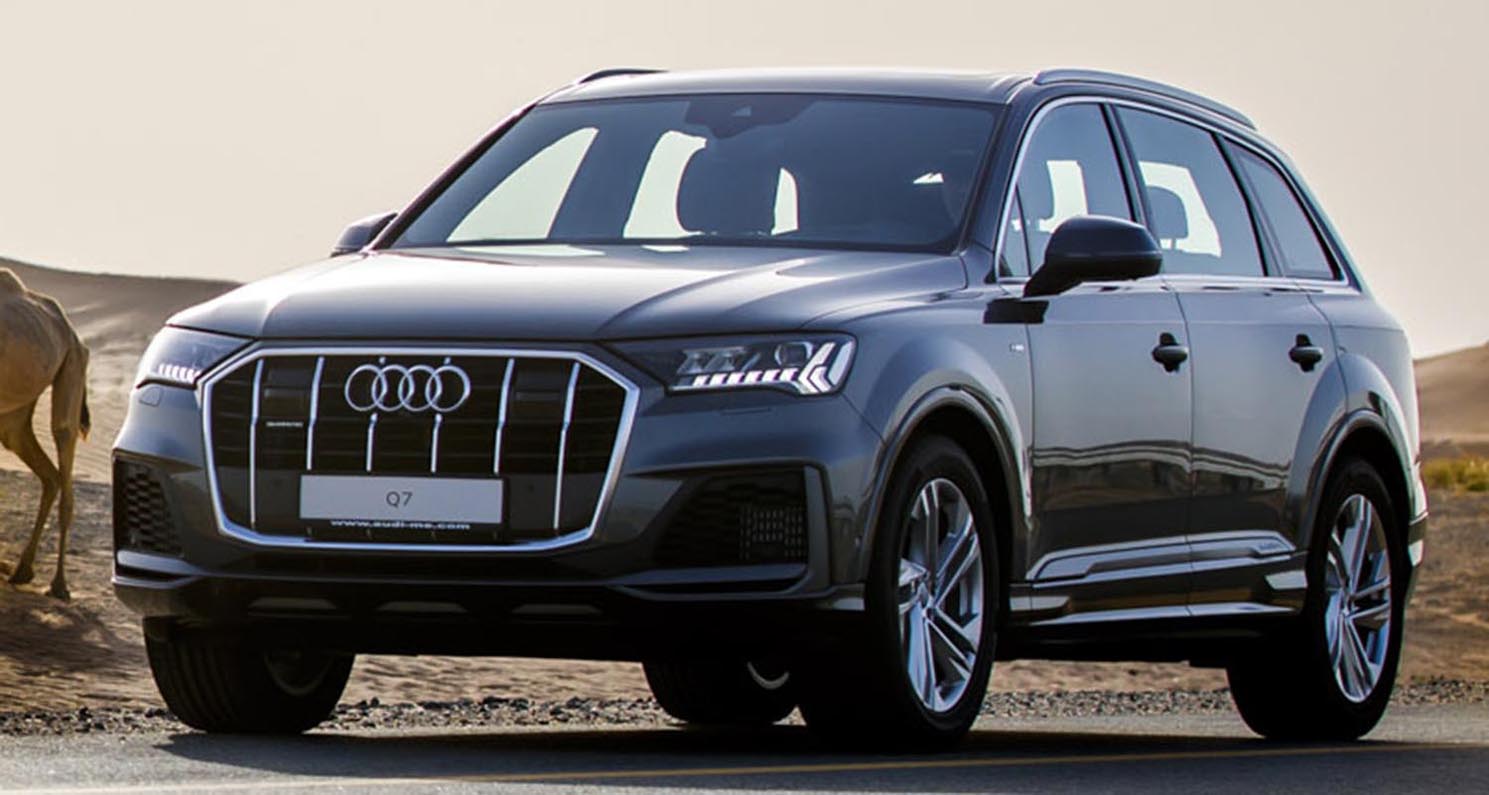
Large wheels, powerful brakes: the axle concept
The front and rear axles of the large SUV are designed as five-link suspension. As a result, they can handle the longitudinal and lateral forces acting there separately. The linkages and the subframes are made largely of light aluminum. The track width is 1,679 millimeters (5.5 ft) at the front axle and 1,691 millimeters (5.6 ft) at the rear axle.
18-inch wheels with 235/65 tires come standard, with the option of up to 22 inch wheels with 285/35 size tires. The vehicle is equipped with a 17-inch brake system with single-piece brake discs and an aluminum six-piston fixed caliper at the front as standard. The brake disc chambers and the discs are made of cast iron. They have a diameter of 350 millimeters (13.8 in) at the front and 330 millimeters (13.0 in) at the rear. All seven-seaters and the Audi Q7 55 TFSI are equipped with a two-piece 18-inch brake with aluminum brake disc chambers and a cast iron friction ring. The latter is thermally and mechanically decoupled from the brake disc chamber, which allows it to expand freely when heat develops. The discs have a diameter of 375 millimeters (14.8 in) at the front axle and 350 millimeters (13.8 in) at the rear axle. As a visual eye-catching feature, the brake calipers for the S line model are also available in a red paint finish. Carbon fiber-reinforced ceramic brake discs with specially developed cooling ducts are also available for drivers with special requirements. They are extremely light and wear-resistant, and their calipers are painted in anthracite gray.
Drive
Audi is introducing the new Q7 to the European market with three engines: two TDIs and one TFSI. Both the TDIs and the TFSI are V6 engines with 3.0 liters of displacement and turbocharging. All engines impress with their strong performance and low consumption. They are certified according to the Euro 6d-TEMP standard. The SCR tank of the diesel models holds 24 liters (6.3 US gal). A plug-in hybrid, which is combined with a V6 TFSI, will complete the product line a few months after the market launch.
Two power levels: the 3.0 V6 TDI
The 3.0 TDI is a high-tech engine. Its crankcase and the cylinder heads have separate coolant circuits that allow the temperature to be adjusted to the ideal level in each situation. The piston rings and pins are designed for minimum friction; the oil pump is fully variable. Switchable hydraulic engine mounts connect the 3.0 TDI to the subframe of the front axle. At idle, they eliminate the engine vibrations with soft characteristic curves; while driving, the mounts use higher damping to suppress them.
In the Audi Q7 45 TDI, the V6 diesel produces 170 kW (231 metric hp) of power and 500 Nm (368.8 lb-ft) of torque. It accelerates the large SUV from a standstill to 100 km/h (62.1 mph) in 7.1 seconds and on to a top speed of 229 km/h (142.3 mph). It consumes just between 7.1 and 6.8 liters of fuel per 100 kilometers (33.1 – 34.6 US mpg), which corresponds to 186 to 179 grams of CO2 per kilometer (299.3 – 288.1 g/mi). The Q7 50 TDI delivers an even greater performance: This engine generates 210 kW (286 metric hp) and delivers 600 Nm (442.5 lb-ft) of torque to the crankshaft. The key data: 0 to 100 km/h (62.1 mph) in 6.3 seconds, top speed 241 km/h (149.8 mph), 6.9 – 6.6liters of fuel per 100 kilometers (34.1 – 35.6 US mpg), 181 – 174 grams CO2 per kilometer (291.3 – 280.0 g/mi).
Top engine: the 3.0 V6 TFSI
The new 3.0 TFSI in the Audi Q7 55 TFSI is the most powerful engine in the range. The V6 gasoline unit generates 250 kW (340 metric hp) and 500 Nm (368.8 lb-ft) of torque. It accelerates the large SUV from 0 to 100 km/h (62.1 mph) in 5.9 seconds, and its top speed is electronically limited to 250 km/h (155.3 mph). Fuel consumption per 100 kilometers is between 9.1 and 8.7 liters (25.8 and 27.0 US mpg), which corresponds to 208 to 199 grams of CO2 per kilometer (334.7 – 320.3 g/mi).
The three-liter V6 spark-ignition engine with its aluminum crankcase weighs just over 170 kilograms (374.8 lb). Its exhaust end lies inside the 90° V, the short gas paths and the twin scroll turbocharger, which prevents unfavorable interactions between the gas columns, guarantee spontaneous throttle response.
Audi developed what is known as the B-cycle combustion process specially for the partial-load range. It increases the efficiency of the 3.0 TFSI by means of special valve timing. To support it, the Audi valvelift systemadjusts the intake valves in two stages based on load and engine speed. In the 3.0 TFSI, the coolant also circulates in separate circuits for the crankcase and the cylinder head. The exhaust manifolds are integrated into the cylinder heads; this helps the engine heat up quickly after a cold start.
BAS and lithium-ion battery: mild hybrid technology
All engines in the new Audi Q7 are extremely efficient. This strength largely comes down to the standard mild-hybrid technology. In everyday operation, this technology can reduce consumption by up to 0.7 liters per 100 kilometers. Its central component is a belt alternator starter that is connected to the crankshaft and supplies a 48-volt main electrical system with energy. A compact lithium-ion battery that is mounted beneath the luggage compartment floor stores the power. During deceleration, the BAS can recover up to 8 kW of energy.
If the driver takes their foot off the accelerator at speeds between 55 and 160 km/h (34.2 and 99.4 mph), the Audi Q7 recuperates energy, rolls in idle, or coasts for up to 40 seconds with the engine switched off. The engine management decides which of these three functions to activate depending on the current driving situation, the setting in the transmission program, and the mode in Audi drive select. As soon as the driver accelerates, the BAS restarts the engine more quickly and smoothly than a conventional pinion starter. The start-stop range begins at 22 km/h (13.7 mph). The engine starts from a standstill as soon as the vehicle in front of the Q7 starts moving, even if the brake pedal is still depressed.
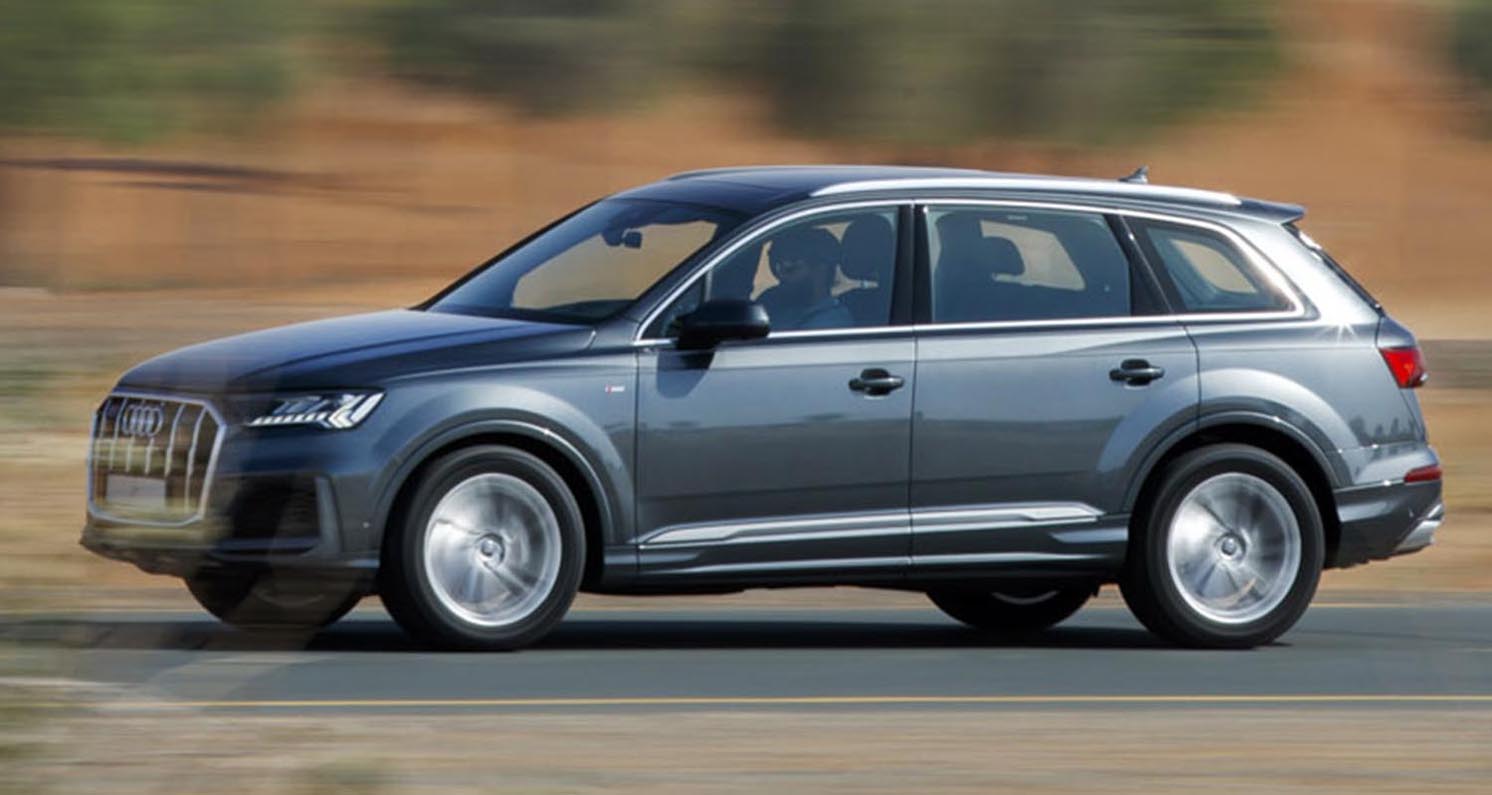
Extremely smooth and lightning-fast: the transmission
All engines in the Audi Q7 work in conjunction with an eight-speed tiptronic as standard. It integrates a torsional damper with a centrifugal force pendulum that largely compensates unwanted vibrations of the engine. In doing so, it enables fuel-efficient driving even at very low speeds. When coasting and rolling in idle, a clutch in the central transmission opens and interrupts the power connection. An electric oil pump makes it possible to engage the gear that will be needed after the rolling phase.
The permanent all-wheel drive is installed as standard in every Q7. The self-locking, purely mechanical center differential – the heart of the quattro drive system – is integrated in the housing of the torque converter automatic transmission. Normally it distributes the torque between the front and rear wheels at a ratio of 40:60. If one wheel slips, most of the drive torque goes immediately to the axle with the better traction. Up to 70 percent can flow to the front wheels and up to 85 percent to the rear wheels. During sporty driving, wheel-selective torque control, an intelligent software function of the Electronic Stabilization Control, perfects the handling: It minimally brakes the wheels on the inside of the curve, thus routing the drive torque to the wheels on the outside of the curve with the higher wheel load. The difference in propulsive forces turns the car into the bend, allowing the car to follow the steering angle precisely and making the handling characteristics even more precise and agile.
Interior and controls
Whether with five or seven seats, the Audi Q7 offers practical everyday qualities. It outdoes its direct competitors in terms of interior length as well as headroom and elbow room in the front and rear. A host of storage compartments, a new compartment in the instrument panel as well as the generous load capacity provide highly functional utility value. With the five-seater version, the luggage compartment offers up to 865 liters (30.5 cu ft) of capacity, depending on the equipment. Folding down the rear seat backs creates a flat load area and a maximum stowage space of 2,050 liters (72.4 cu ft).
An electric tailgate is standard; foot-activated gesture control is available as an option. The electric luggage compartment cover is another convenience option. In addition, Audi optionally supplies the rear seat bench plus; all three seats can be moved individually fore/aft, and the backrest angle can be adjusted. There is also a third seat row with two seats that can be lowered electrically.
Spacious and noble: the interior
In the interior of the Audi Q7, distinct horizontal lines and the lean instrument panel emphasize the feeling of width. The architecture is in perfect harmony with the new operating concept, creating a design language that appears clear and elegant. Like its sister model, the Q8, the Audi Q7 also uses the digital MMI touch response concept with two large touchscreens. When it is off, the top display joins almost invisibly into the large black decorative surface. When it is active, its distinctive, quickly understandable graphics reflect the digital precision of Audi.
All the design elements, volumes, and lines of the instrument panel make logical reference to one another, from the flat air vent door strip to the light switch module, which can include a touch-response surface as an option. In the dark, the contour ambient lighting package, which comes as standard with the interior design selection, illuminates the interior. As an option, Audi offers further convenience features, such as a power-assist function for closing the doors quietly, the convenience key, a heated windshield, four-zone automatic air conditioning, and the air quality package with fragrancing and ionizer. Customers can choose from three multifunction steering wheel variants, two of which have shift paddles for the eight-speed tiptronic.
From elegant to sporty: the interior lines
The basic interior includes even a four-stage range for the seat upholstery, from cloth to the refined Valcona/cricket leather combination. Top-of-the-line options include the customized contour seats with climate control, optionally also with massage function. Ten pneumatic cushions, each with five programs and intensities, relax the back muscles. A similar grading applies to the interior design selection, featuring upholstery in partial leather or in top quality depending on the color, both with contrasting stitching. The interior design selection is completed by a three-spoke leather steering wheel, a leather-covered instrument panel, illuminated door sill trims, the contour/ambient lighting package, as well as a stainless steel loading sill protector.
In the case of the S line interior, the second alternative, the Audi Q7 is equipped with sport seats that feature an S embossing on the front backrests. The available materials are pearl Nappa/Alcantara and Valcona leather. As an option, Audi can mount the S sport seats plus with integrated head restraints, pneumatically adjustable seat and backrest side bolsters, and rhombus pattern. The massage function and climate control can also be added here. The footrest and pedals of the interior S line are made of stainless steel, the trim strips of matt brushed aluminum.
The selection of numerous colors and materials rounds off the character of the interior with sporty elegance and top-of-the-line workmanship. For the upholstery, the customer can choose from seven colors with six material options available for the inlays, including various wood veneers and aluminum. Almost all veneers are open-pored. The eucalyptus wood with its grayish-blue color effect is a new addition. Customers who wish to further individualize their Audi Q7 can select from four leather packages and the special offers from the Audi exclusive program. The basic interior, the interior design selection, and the interior S line can be freely combined with the two exterior lines.
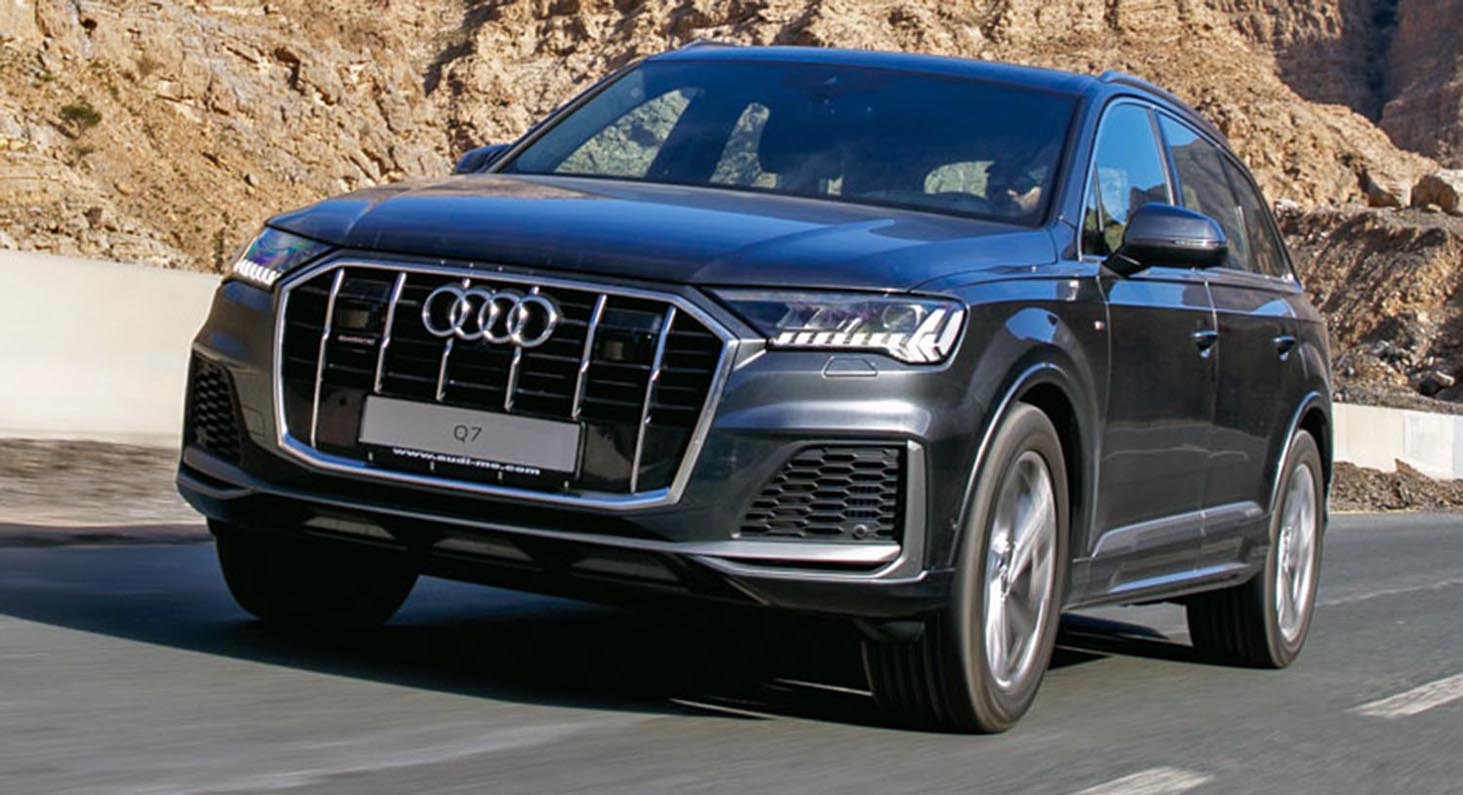
New concept: two touch displays with haptic feedback
The operating concept of the new Q7 is at the current level of the Audi full-size models: Two large, high-resolution displays replace many buttons and controls as well as the touchpad on the tunnel of the center console that was installed previously. The upper display is used for controlling infotainment and navigation. With the standard MMI radio plus system, it has an 8.8-inch diagonal, while the diagonal is 10.1 inches with the optional MMI navigation plus. The driver uses the lower 8.6-inch display to manage climate control, the convenience functions, and text input, including via hand writing. The MMI touch response concept allows fast and reliable operation: A tactile and acoustic click confirms when a finger activates a function. The menu structure is lean and clear, just like on a smartphone, and the MMI search is based on free text input. For many searches, the hit list will appear after just a couple of letters have been entered.
On-board and online: natural language control
As an additional operating level besides the touch displays, MMI navigation plus features natural language voice control. The driver can use almost any wording; the system understands sentences such as “I’m cold” and will then increase the setting for the interior temperature. The dialog goes beyond menu boundaries. For example, the user can call a contact from the telephone book and add the address as a navigation destination. The voice control draws information for its responses to commands and questions not only from the information stored online, but also from the cloud. While online language cross-referencing improves the detection rate and quality of results, the advantage of the onboard information lies in its rapid, reliable availability – even in the absence of a mobile network, say in an underground parking garage.
Fully digital: the Audi virtual cockpit
MMI navigation plus will be joined by the Audi virtual cockpit in the Q7, which will be installed in place of the partially analog instrument cluster. Its high-resolution 12.3-inch display with 1,920 x 720 pixels can be switched between two views with the multifunction steering wheel. The Audi virtual cockpit plus option offers a third interface with a particularly sporty look. The head-up display is a further piece of optional equipment that displays important information in the driver’s primary field of vision. The image has a field of view of 5.4° x 2.1° and appears to be hovering above the hood at a distance of 2.3 meters (7.5 ft). This corresponds roughly to the size of an iPad at that distance. The information shown includes the speed, driver assist, traffic signs, and a detailed intersection map.
Infotainment and networking
Equipped with the optional MMI navigation plus, the new Audi Q7 is a highly connected car. Its integrated Audi connect data transfer module comes not only with a Wi-Fi hotspot, but also with the fast LTE Advanced transmission standard. The navigation system offers the driver intelligent destination suggestions based on previously driven routes, taking into consideration past experience with respect to the time of day and traffic loads. The route is calculated online on the servers of the map and navigation provider HERE, using real-time data for the overall traffic situation. If the data connection is lost, the system switches to the on-board routing running in parallel.
Get to the traffic light on green: the Audi connect services
With the MMI radio plus, the Audi Q7 has a package from the service offer of Audi connect on board: the functions of Audi connect safety and service, which are divided into the areas of emergency call & service and vehicle remote control. The offer is made even more attractive with the services of Audi connect navigation & infotainment, which are linked to MMI navigation plus. These services include traffic information online, navigation with Google Earth™, and the hybrid radio, which switches between FM, DAB+, and web stations independently in order to always ensure the best possible reception. The customer can use the touch display of the MMI to select points of interest such as parking garages or sights in the navigation map and view fuel prices, photos, opening hours, and ratings. The navigation map is designed with a new texture and includes 3D models of many large cities. During the first three years after purchasing the new car, the user can update it free of charge four times a year.
The Audi connect navigation & infotainment portfolio also includes the Car-to-X services that draw on the swarm intelligence of the Audi fleet. Apart from online traffic sign and hazard information, as well as the on-street parking service, traffic light information is a new addition to the lineup. Because the car is connected with the city’s infrastructure, it receives information from the main traffic light computer via a server. This allows the driver to adjust their speed so that they get to next traffic light on green. The Audi virtual cockpit and the optional head-up display provide an individual speed recommendation as well as the remaining time until the next green-light phase, even if the driver is already waiting at a red light. The system thus contributes to a predictive and efficient driving style and facilitates a steady flow of traffic. The offer will be rolled out step by step in selected European cities.
Audi connect also includes the cloud-based Amazon voice service Alexa, which is integrated into the MMI operating system. The driver can use it to place orders and get information on various current events. Alexa streams music and audiobooks and provides access to over 80,000 Alexa skills. The smart home control allows users to lock doors in the house, adjust the lighting and close the garage door from within the car.
The Audi smartphone interface is used to integrate iOS and Android smartphones in the onboard infotainment system. It establishes the connection to the mobile device and transfers its native environment, Apple Car Play or Android Auto, to the MMI display – this can even be done wirelessly with the iPhone. Customers can use the myAudi app to connect the Q7 with their smartphone – even outside of the vehicle. The app provides the myAudi navigation and controls the Audi connect assistance and remote services. In addition, the smartphone calendar can be transferred to the MMI system. The optional digital Audi connect key authorizes an Android smartphone to not only lock and unlock the vehicle, but also to start the engine via the start/stop button. Data is exchanged via near field communication. Up to seven drivers can store their preferred settings in individual profiles. This personalization encompasses up to 400 parameters, from climate control to navigation destinations and media. The car recognizes the particular user from their key signal when the car is unlocked and activates the associated individual profile automatically.
The infotainment program is complemented by attractive hardware components: The Audi phone box connects the smartphone to the vehicle’s antenna and charges the phone inductively. It uses Voice-over-LTE to connect faster and makes it possible to use high-speed data transfer and high-resolution online voice telephony at the same time. The Bang & Olufsen Advanced Sound System carries the 3D sound with its elevation information to the first row of seats via 23 loudspeakers. The music sounds exactly how it was recorded in the concert hall.
Poised and safe on the road: the driver assist systems
An extensive range of driver assist systems is available for the new Audi Q7, divided up into the Tour and City packages. The adaptive cruise assist, which combines the functions of adaptive cruise control, traffic jam assist, and active lane assist, reduces the driver’s workload particularly on long journeys. In combination with the efficiency assist it brakes and accelerates the large SUV in anticipation of the conditions ahead. To do so it analyzes sensor information, navigation data and traffic signs. The camera-based traffic sign recognition is also part of this package, as are turn assist and collision avoidance assist, which prevent collisions with oncoming vehicles or vehicles ahead.
The City assist package includes the crossing assist, lane change warning, exit warning, and cross traffic assist rear. With Audi pre sense 360°, the Audi Q7 also offers all-round safety: The system detects risks of collision in the vehicle’s environment and initiates targeted protective measures. It consists of the following assist systems: Audi pre sense front, Audi pre sense rear, Audi pre sense basic, and Audi pre sense side. The latter registers impending side collisions up to a vehicle speed of 60 km/h (37.3 mph) due to crossing vehicles or vehicles approaching from the side.
The 360 degree cameras assist the driver as an individual option, allowing the driver to switch between multiple views. They provide a view of the cross traffic, a detailed view of the wheels, and a 3D view with freely selectable perspective. The camera-based trailer maneuver assist, which reduces the driver’s workload when reversing and maneuvering with a trailer, is also available as an option. The driver can steer the trailer using the lower MMI touch display.
Backing many of these systems is the central driver assistance controller, which continuously computes a differentiated model of the environment. This way, the assist systems can react precisely and in good time to objects, such as by initiating braking. Navigation is also highly precise because the sensor data fusion locates the car down to the exact lane. Depending on the selected options, the central driver assistance controller receives the data to do this from up to five radar sensors, five cameras, and twelve ultrasound sensors.


